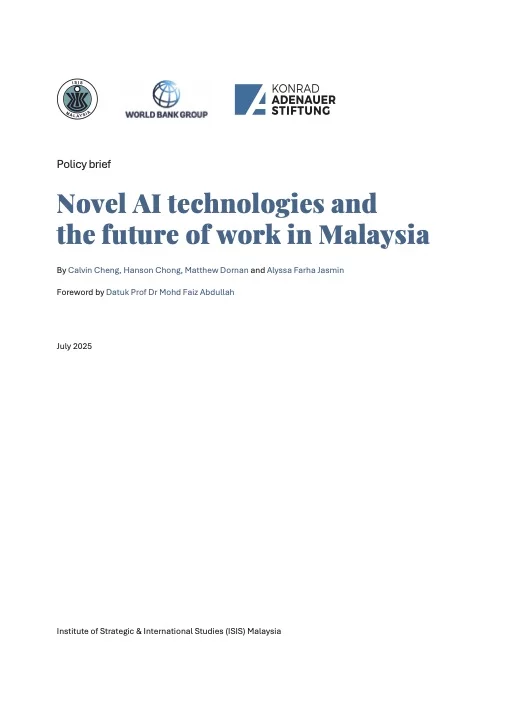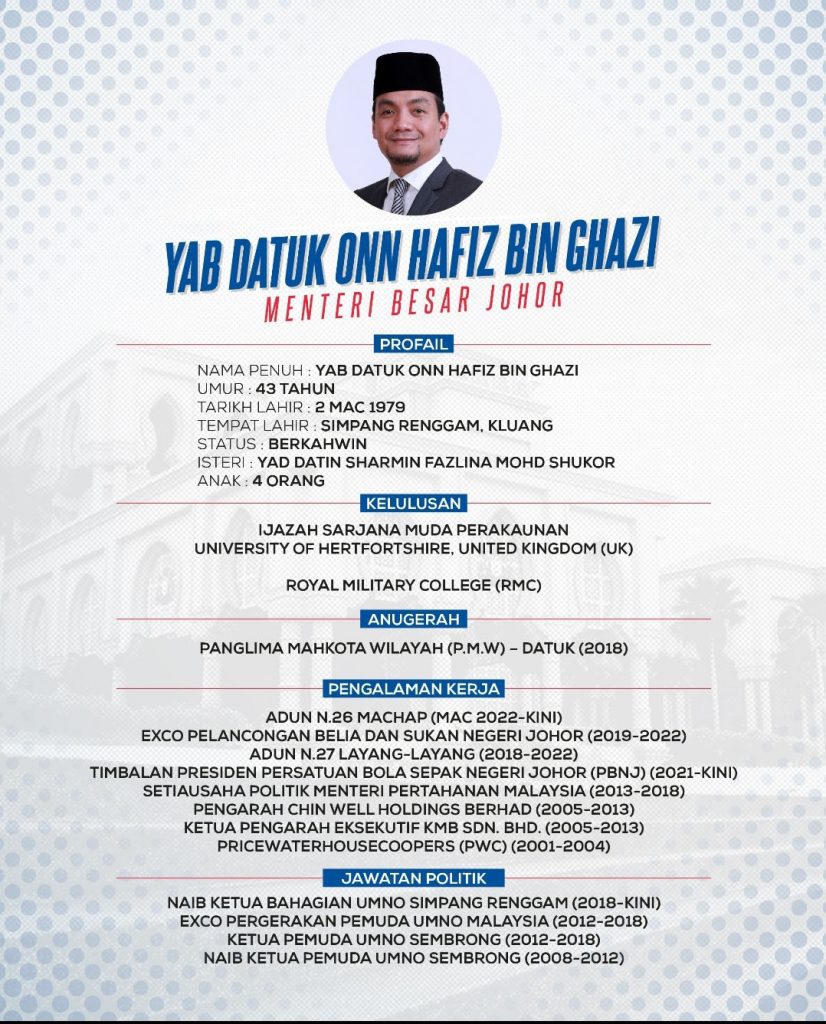By Calvin Cheng, Hanson Chong, Matthew Dornan and Alyssa Farha Jasmin
Foreword by Datuk Prof Dr Mohd Faiz Abdullah
July 2025
Executive summary
- Generative AI technologies build on past waves of labour-shaping technologies. This paper uses a task-based framework, eMASCO and Labour Force Survey microdata to assess job and socio-demographic exposure to generative AI technologies (Section 2).
- We estimate that 4.2 million Malaysian workers – or 28% of the labour force – are “highly exposed” to generative AI technologies, while another 2.5 million workers fall in the medium-high exposure category. Overall, nearly half of the workforce has at least 40% of its tasks substitutable by today’s generative AI capabilities, with these tasks primarily reflecting structured, screen-based, non-physical work (Section 3.1).
- Exposure is uneven: regression analysis using our AI exposure metrics indicates that women, younger workers, clerical workers and urban workers are more likely to be in higher-AI-exposed jobs. We also find evidence of “plateau” effects across wage, education and skill – meaning that AI exposure plateaus or falls at the highest levels of wage and education (Section 3.2).
- Analysing MASCO skills, we suggest that occupations anchored in “human-edge” skills, complex judgement, social-emotional intelligence, interpersonal reasoning and creativity might gain wage premiums as generative AI adoption increases, while routine cognitive and non-routine-structured roles could see growing wage pressure. Even so, many occupations require a combination of both high- and low-exposed skills, pointing to the potential for AI to complement existing workflows (Section 3.3).
- Finally, we outline avenues towards strengthening social protection systems so that all workers, including those engaged in non-standard work, are better able to weather potential AI-driven disruptions. We also suggest changes to education, training and lifelong-learning pathways to equip Malaysians with the “human-edge” skills for the future of work, along with measures to broaden access to these learning pathways. Third, we suggest some ways to realign labour-market institutions and employer incentives to favour labour-complementary adoption and raise job quality in occupations that are resilient to automation (Section 5).
1 Background and literature review
Past waves of technological change
Technology has continually reshaped work, driving economic, social and political change across human history – and novel AI technologies are the latest in this trajectory. From the Neolithic Revolution and the invention of agriculture and domesticated farming some 12,000 years ago, through to the rise of computerisation in the 1980s and industrial robots in the 2000s, technological advancements have transformed how work is structured, who performs it and, more importantly, who benefits (and who does not). These shifts are shaped by technological capabilities, but also how technology interacts with institutional and policy choices. Generative AI builds on past waves of automation technologies to a new boundary hitherto untouched by capital: the automation of cognitive tasks previously thought to be the exclusive domain of human ability.1
Technological change is widely regarded as a universal force for advancement. The invention of agriculture enabled surplus food production and spurred the rise of civilisations, while the Industrial Revolution enabled unprecedented gains in productivity and incomes – albeit initially for a privileged few.2 More recently, digital technologies have revolutionised global communication, expanded access to knowledge and education, reduced transaction costs and democratised innovation worldwide. Viewed over the span of centuries, each wave of technological change throughout human history appears to have uplifted humanity, reinforcing the perception that technology is both an inevitable and universal force for good. In this context, any attempt to control or guide its trajectory can appear futile or even at odds to the ideals of continued social and economic progress.
However, each new wave of technological change also brings both short-term disruptions and long-term social and economic implications. The emergence of a new general-purpose technology often displaces workers and industries. In the United Kingdom, mechanisation during the Industrial Revolution drove rapid productivity gains but also depressed real wages for workers while concentrating wealth among capital owners.3 Only after decades of policies aimed at increasing the bargaining power of workers and broader socio-economic shifts did this increased productivity spill over to higher living standards more broadly in the late 19th century.4 5 In the United States, inequality remained high well into the Gilded Age; it took the shock of the Great Depression and sweeping labour and welfare reforms for productivity gains to translate into broader prosperity.6
More recent waves of technological change have brought greater productivity, but also negative longer-term consequences for workers. Frey (2019) argues that the computerisation of routine-cognitive jobs since the 1980s have improved productivity and lowered costs, but have also lowered wages for lower-skilled workers.7 The rise of industrial robots in the 2010s affected local labour markets by driving down employment and wages – particularly for physical-routine jobs.8 9 10 Indeed, the adjustment costs of technological change can be substantial, particularly if entire industrial regions are hollowed out and if the technological change is sufficiently skill biased. This job displacement cannot easily be offset by “reallocation” or “reskilling” either – recent research suggests that displaced workers affected by current waves of technological change end up downgrading to lower-paying, lower-quality jobs.11 12 In this way, what begins as short-term disruptions can have long-lasting and far-reaching consequences on broader social and political dynamics. There is evidence linking the economic impacts of many technological shifts to declining social cohesion, changing political preferences, and increased polarisation.13 14 15
Rise of novel AI technologies
Early evidence shows that the pace of adoption and development of emerging AI technologies are far more rapid than previous technological waves. Recent estimates indicate that the diffusion of generative AI has been about five times faster than that of mobile phones and that its overall adoption has outpaced both personal computers and the internet.16 Simultaneously, the pace of generative AI development has also been far quicker, with capabilities rapidly converging to the frontier of human cognitive abilities in a short span of time. In a single year, OpenAI’s flagship large language model improved from scoring in the 10th percentile to exceeding the 80th percentile on the US Bar Exam.17 As such, while past waves of automation primarily displaced manual and routine cognitive tasks, generative AI is advancing rapidly into high-skill domains, including professional and creative work. These unprecedented advances in both diffusion and development constrain policy space and limit the ability to draw insights from past technological transitions. They also pose significant risks for existing policy frameworks and social protection systems designed for more gradual shifts in the nature of work.
Increased generative AI adoption can affect workers and labour markets by impacting job tasks as well as through broader macroeconomic effects. At the job level, generative AI can directly automate specific tasks within occupations, shifting the balance between capital and labour in production. Indeed, past waves of capital-intensive technological change have contributed to a global decline in the labour share of income over the past few decades.18 19 At the same time, emerging evidence indicates that generative AI may increase productivity for certain tasks and occupations – though there are wide disparities across gender and task complexity.20 21 This raises important questions at the macroeconomic level: while higher productivity could in theory increase aggregate labour demand, this requires AI to increase the marginal productivity of labour or foster enough new jobs and industries to compensate for losses elsewhere. If AI primarily substitutes for labour without enabling complementary roles, overall labour demand could decline, even as output rises. Preliminary evidence indicates that recent automation may be reducing the marginal productivity of labour, while the degree to which AI can spur new task creation remains an open question.22 23 24
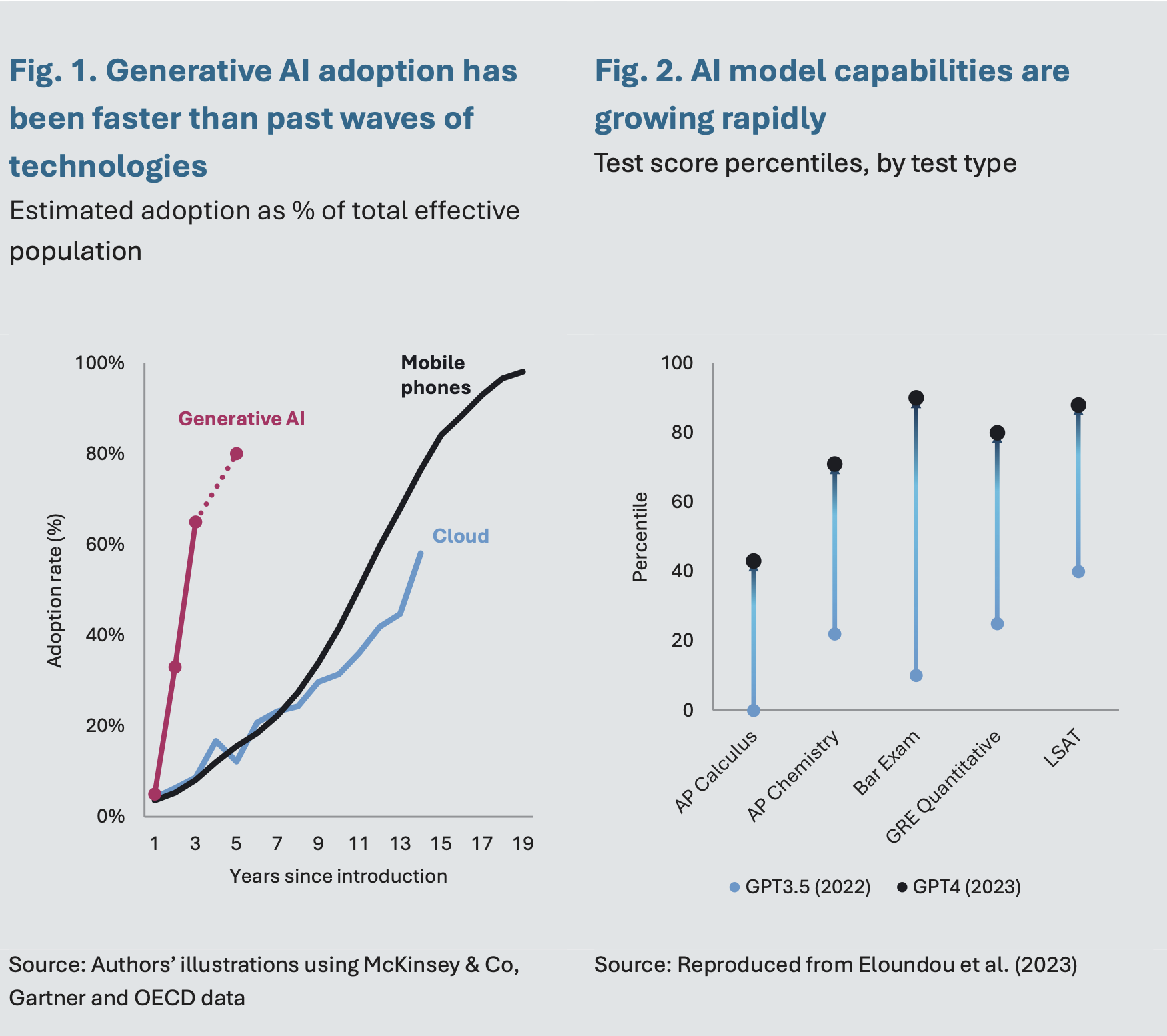
Current research on the impacts of generative AI on employment show that exposure is relatively high across both advanced and developing countries, though not all exposed workers are at risk of automation. Gmyrek et al. (2023) estimate that 13% of global employment or about 427 million jobs may be “augmented”, meaning that AI could take over more routine aspects of their tasks to enable them to focus on more complex functions, thereby increasing productivity.25 In contrast, about 2.3% of employment, or about 75 million jobs are at risk of automation, meaning that generative AI is already capable of replacing most of their tasks, thereby threatening employment.26 Pizinelli et al. (2023) approximate that in advanced economies like the United States and the United Kingdom, some 30% to 40% of employment fall within the top 20th percentile of AI-exposed occupations, while in emerging markets like Brazil, Colombia and South Africa, less than 15% of employment can be similarly classified as highly exposed.27 In Malaysia, a recent TalentCorp (2024) report estimates that about 18% of all Malaysian workers in 10 strategic sectors will be “highly impacted” by AI, the green economy and digital technologies in the next three to five years.28 This disparity across countries reflects differences in occupational structures, with advanced economies having a larger share of high-skill, cognitive-intensive roles that are more susceptible to generative AI integration. Nonetheless, while automation exposure is generally higher in high-income countries than in lower- and middle-income countries, advanced economies also have a greater proportion of highly exposed jobs that exhibit strong complementarity with AI – suggesting potential for AI to boost productivity. In contrast, in emerging economies, a greater share of exposed occupations has low complementarity potential, increasing the risk of job displacement as AI adoption progresses.
Within countries, evidence suggests that the impacts of generative AI are uneven and unequal. Women are more likely to be affected than men because of their concentration in service and retail jobs, which are highly susceptible to automation. In the US, for instance, 68% of women are in high-exposure occupations, compared with 51% of men. In Brazil, the figures stand at 52% and 32% respectively. 29 Gmyrek et al. (2023) similarly find that globally, women are more than twice as likely as men to hold jobs at risk of automation, with 8% of women’s employment in high-income countries being automatable compared with 3% of men. 30 Likewise, AI’s impact also varies by existing computer-use intensity, meaning workers in occupations with greater digital adoption tend to be more exposed as AI substitutes more cognitive and clerical tasks.31 32 At the same time, these occupations also hold higher potential for AI complementarity, particularly in professional and managerial roles. Workers with a college degree face greater occupational exposure to AI across both advanced and emerging economies, but they are also more likely to be in roles where AI serves as an augmentation tool rather than a substitute.
Malaysian policy context
In response, Malaysia introduced multiple policies that reflect the government’s commitment to AI adoption and integration. The first major policy initiative, the Artificial Intelligence Roadmap (AI-Rmap) 2021–2025, was introduced by the Ministry of Science, Technology, and Innovation (MOSTI) to develop Malaysia into a high-tech, AI-driven nation. This roadmap laid the foundation for AI governance, including the creation of the AI Coordination and Implementation Unit (AI-CIU) to oversee AI ethics, policy and regulation, as well as talent development, among others. Concurrently, the Malaysia Digital Economy Blueprint, launched in 2021, outlined a broader digital transformation strategy known as MyDIGITAL, where AI was briefly acknowledged as a tool for enhancing public sector productivity. Subsequently in 2023, the New Industrial Master Plan 2030 (NIMP 2030) was introduced, gearing Malaysia’s AI focus towards industrialisation and economic complexity. AI is framed as an enabler of smart manufacturing, automation and supply chain efficiencies, aligning Malaysia with Industry 4.0 and advanced robotics.
Policy documents like NIMP also highlight that Malaysia aims to position itself as a market leader in AI technologies. In 2024, the Ministry of Digital introduced a separate AI governance body, the National AI Office (NAIO), to “accelerate AI adoption, foster innovation and ensure ethical development of AI”. In Budget 2025, the government allocated funds for (i) AI-related research in public universities; (ii) the Malaysia Techlympics to develop young talent specialising in robotics and AI technology; (iii) tax deductions for private universities and institutions developing AI- related courses; and (iv) establishment of NAIO to enhance AI adoption. However, while these policies demonstrate a strong commitment to AI-driven transformation, the proliferation of multiple AI-related policies, particularly, fragmented workforce development efforts – spanning universities, technical and vocational education and training (TVET) programmes and industry collaborations – raises concerns regarding policy redundancy and inefficiency.
This paper examines how generative AI technologies could shape the future of work in Malaysia. The paper addresses two main questions: first, how might generative AI technologies affect Malaysian workers and which groups face the highest exposure? Second, what types of policies are needed to maximise the benefits of technology diffusion while mitigating potential adverse impacts? Here, it is important to clarify that we remain agnostic whether exposure equates to displacement – at this stage, existing measures of complementarity and substitution are highly subjective. Rather, we use the term “exposure” to measure the overlap between technological capabilities and job tasks – overlap which could potentially lead to automation (replacement) or augmentation (complementarity) of human labour. Our analysis assesses whether tasks are automatable in principle by current generative AI technological capabilities, rather than predicting actual automation outcomes, which ultimately depend on a complex interplay of business decisions, political considerations and institutional factors.
The remainder of the paper is structured as follows: Section 2 provides an overview of Malaysia’s labour market, including the theoretical framework and descriptive statistics. Section 3 presents the analysis and results. Section 4 concludes with policy recommendations.
2 Conceptual framework and data
Several methodological approaches exist to assess how AI and automation affect jobs. Broadly, these approaches can be grouped into two categories: labour demand indicators and occupational structure-based methods.33 Demand-based indicators typically use online job posting data to measure demand for AI-specific skills – with the rationale that diffusion of new technologies will show up as changing demands for certain skills.34 35 In contrast, occupation-structure-based approaches rely on detailed country-level classification of occupations – such as the US Department of Labour’s O*NET database or International Standard Classification of Occupations (ISCO) – to estimate automation potential by assessing which tasks can be performed by emerging technologies.36 37 38
This paper adopts an occupational-structure-based approach to evaluate systematically the impacts of generative AI on Malaysia’s labour market. We conceptualise jobs as collection of tasks, enabling a more granular analysis of automation risk at the task level across all occupations (Appendix A1). This method offers broad coverage across all occupations in the labour market while avoiding certain limitations of labour-demand-based approaches, including incomplete coverage in less digitised sectors or informal occupations. Nonetheless, this approach carries several limitations: it does not capture the interaction of generative AI with other complementary technologies, such as robotics, and it cannot directly account for new job creation as occupation-task structures are assumed to be static at a given point in time.39
We applied this approach to a structured occupation-task dataset based on the Malaysian Standard Classification of Occupations (MASCO). MASCO offers a detailed taxonomy of occupations and their associated tasks, publicly accessible the eMASCO platform. For this analysis, we scrape eMASCO to construct a comprehensive dataset that include occupation descriptions, associated task lists and additional occupation-specific details, including required skills and training according to Malaysia’s National Occupational Skills Standards (NOSS) or National Employment Classification (NEC).
To assign generative AI automation scores at the task level, we employed a rubric-based evaluation method informed by recent literature. Following Gmyrek et al. (2023) and Eloundou et al. (2023), we utilised sequential, high-frequency calls (applied to the job-task dataset MASCO) to the GPT-4o API using a set of custom prompts (Appendix A2).40 41 Specifically, for each of the 3,477 job tasks at the 4-digit level, we generated a task-level automation score between 0 and 1, with 1 indicating that that task has the highest potential for automation by generative AI. This exercise essentially compares the semantics of a task to current capabilities of generative AI technologies. Crucially, these scores do not indicate predicted automation outcomes, which depend on factors that we do not take into account, such as the ethical and operational dimensions of AI deployment. Nevertheless, it produces a useful estimate of potential automation of tasks which allows us to investigate how novel technologies might affect jobs.
To measure how exposed each occupation is to generative AI, we aggregated these individual task-level automation scores into a simple, occupation-level AI exposure index. Specifically, we counted the proportion of tasks within each occupation that exceeded a given threshold of automation risk (Appendix A1).42 Notably, this differs from the aggregation method used by Gmyrek et al. (2023), which classifies occupations as either highly automatable, augmentable, insulated, or as belonging to a “great unknown”, depending on their combination of median task-level scores and task-score variability.43 Our simpler, threshold-based approach has the benefit of being more transparent, avoids categorical ambiguity (such as “the great unknown”), and imposes less ex ante assumptions about potential augmentation beyond exposure. Applying this method to our MASCO dataset, we calculated occupational-level AI exposure indices – also ranging from 0 (low exposure) to 1 (high exposure) – for 484 occupations at the MASCO four-digit level and 3,597 occupations at the six-digit level.
Next, we linked our occupation-level AI exposure data with Malaysia’s Labour Force Survey (LFS) to examine how generative AI affects different groups of workers. Specifically, we assessed AI exposure across key demographic and employment characteristics, including gender, age, sector and skill level, to understand the demographics most exposed to generative AI technologies. We also used the more detailed six-digit MASCO occupational-level skill dataset, which provide a list of skills required for each occupation, scraped from eMASCO, to pinpoint which skills are most closely linked to higher or lower AI exposure. Finally, we merged this occupation-skills dataset with data from Malaysia’s Wages and Salaries Survey to look at how wages relate to automation exposure and identify high-value skills in the context of automation intensity.
3 Estimation results
3.1 Exposure of Malaysian occupations to AI
Task-level automation scores reveal significant variations in AI exposure, with structured and routine tasks being generally more automatable, and tasks involving subjective judgement or human interaction being less so. Tasks highly exposed to generative AI automation typically involve predictable, repetitive or text-based activities with less need for subjective judgement. These include tasks like typing or transcribing written materials, proofreading, processing medical records and recording financial transactions (Table 1). Conversely, tasks least susceptible to generative AI automation typically involve complex decision-making or socio-emotional interaction, and/or physical manual dexterity. Examples include amending legislation, providing medical or dental treatments, instructing aviation trainees and therapeutic massage.
At the occupation level, half of Malaysian occupations are in the “medium high” or “high” exposure categories, which means that these occupations have more than 40% of their tasks automatable by generative AI. As detailed in Section 2, we calculate occupation-level AI exposure by measuring the proportion of tasks within each occupation whose automation scores exceed the median task-level threshold (Appendix A1). Occupations in the highest-exposure quartile – such as software developers, financial analysts and application programmers – have an AI exposure index of 1.0, indicating that every single task within these most-exposed occupations is automatable by generative AI in the next three to five years (Fig. 3). These occupations typically consist of structured cognitive activities, such as data analysis, coding and information processing. On the other hand, occupations in the least exposed quartile tend to have a higher proportion of tasks that requires the interpretation of ambiguous and complex information, ethical sensitivity, or significant human interaction. For example, among the seven tasks listed by MASCO for a judge, only one task is deemed automatable by generative AI, while other tasks – including interpreting the law and pronouncing a legal judgement – remain resistant to automation, in contrast to the tasks performed by software developers (Table 2).
Table 1. Tasks with highest and lowest AI automation scores
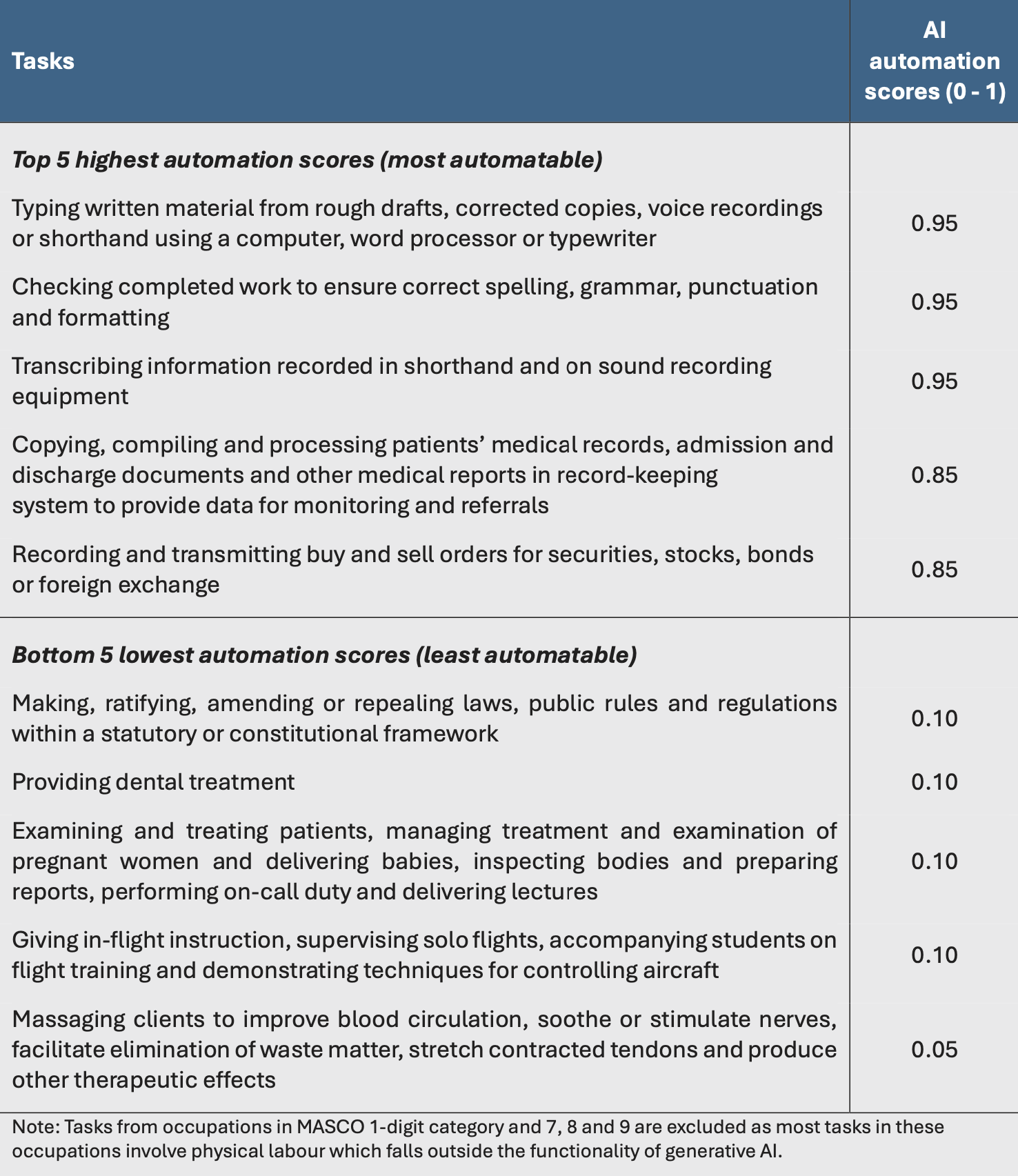
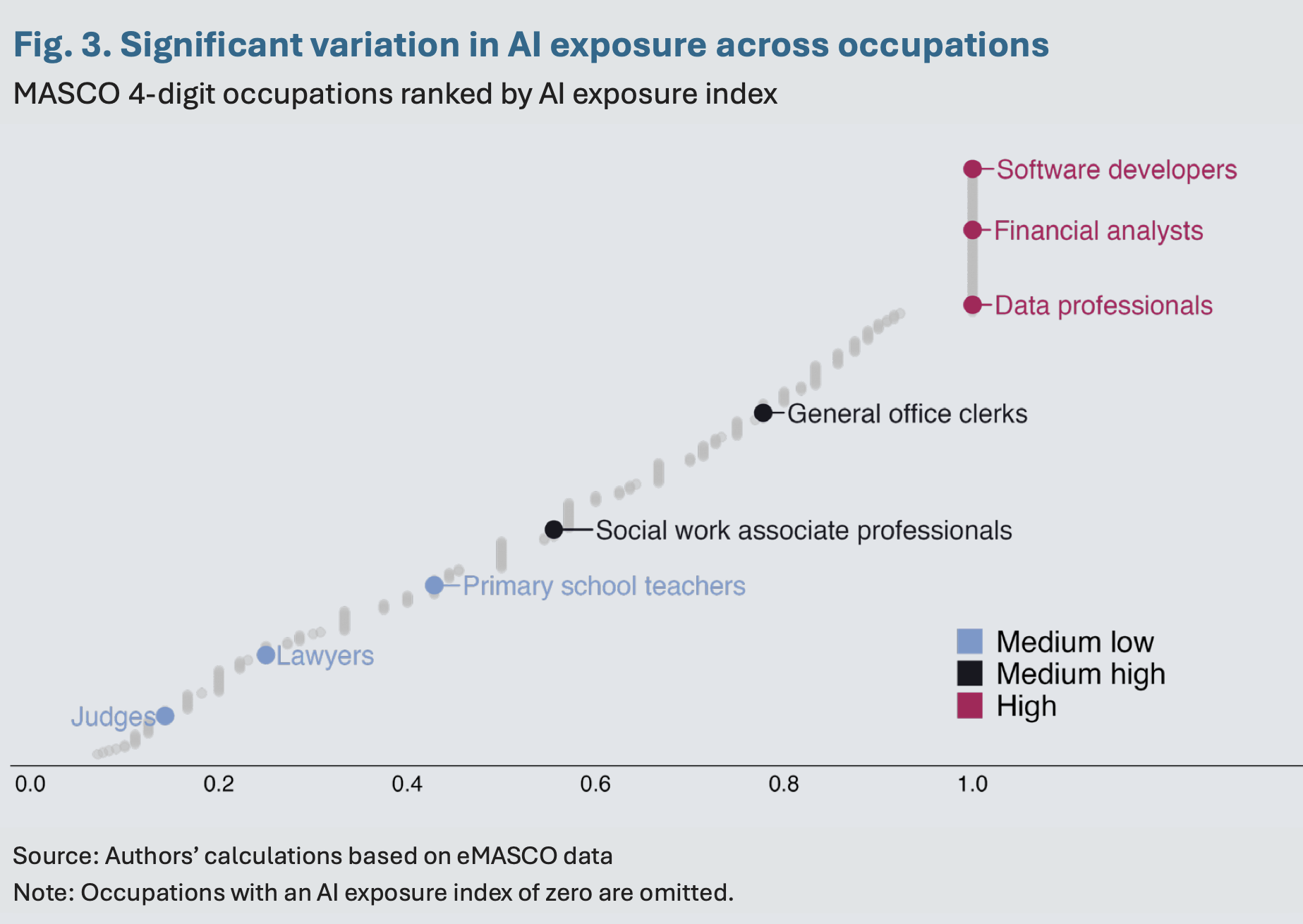
Table 2. Task-level AI automation scores and occupational-level AI exposure scores for selected occupations
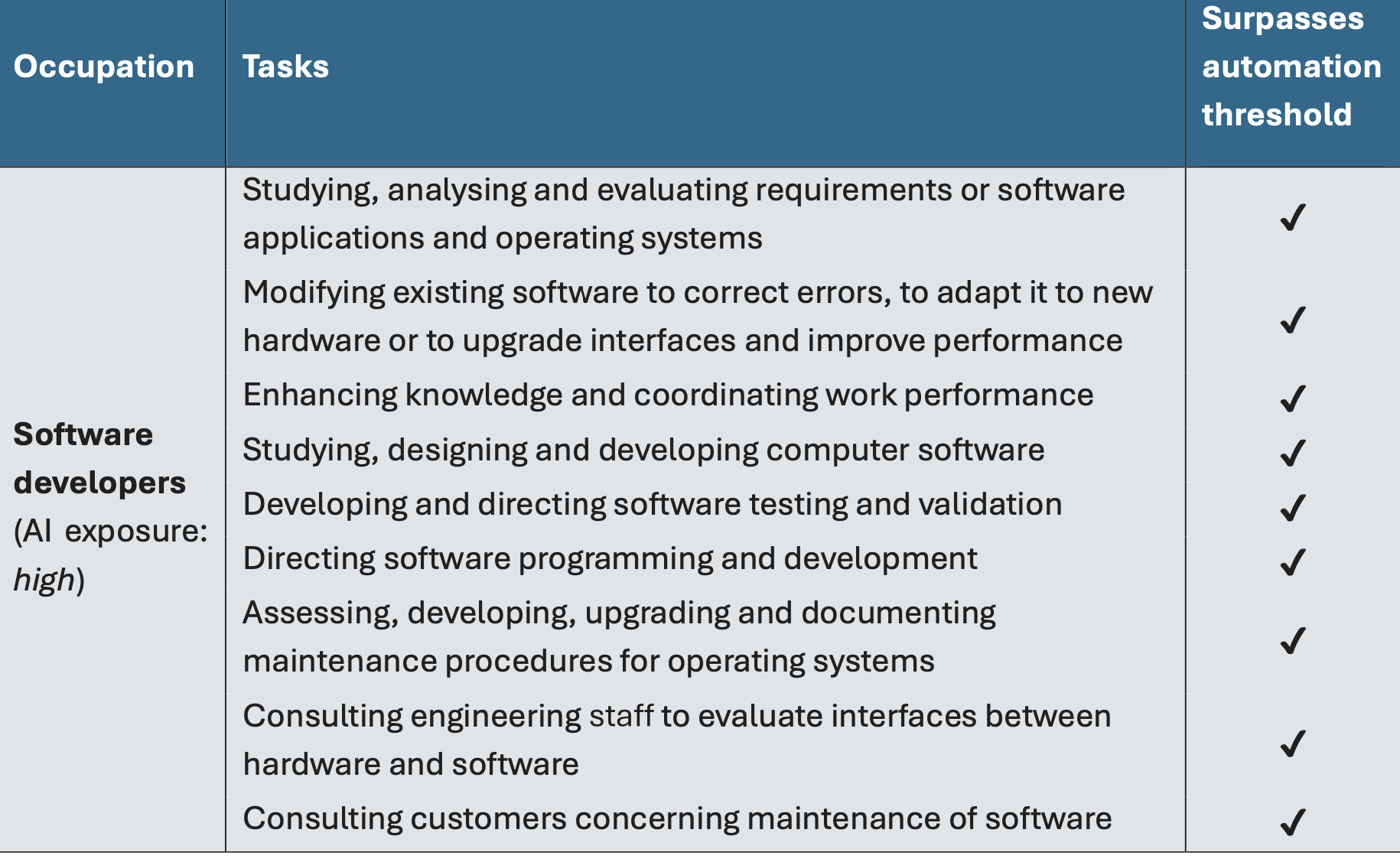
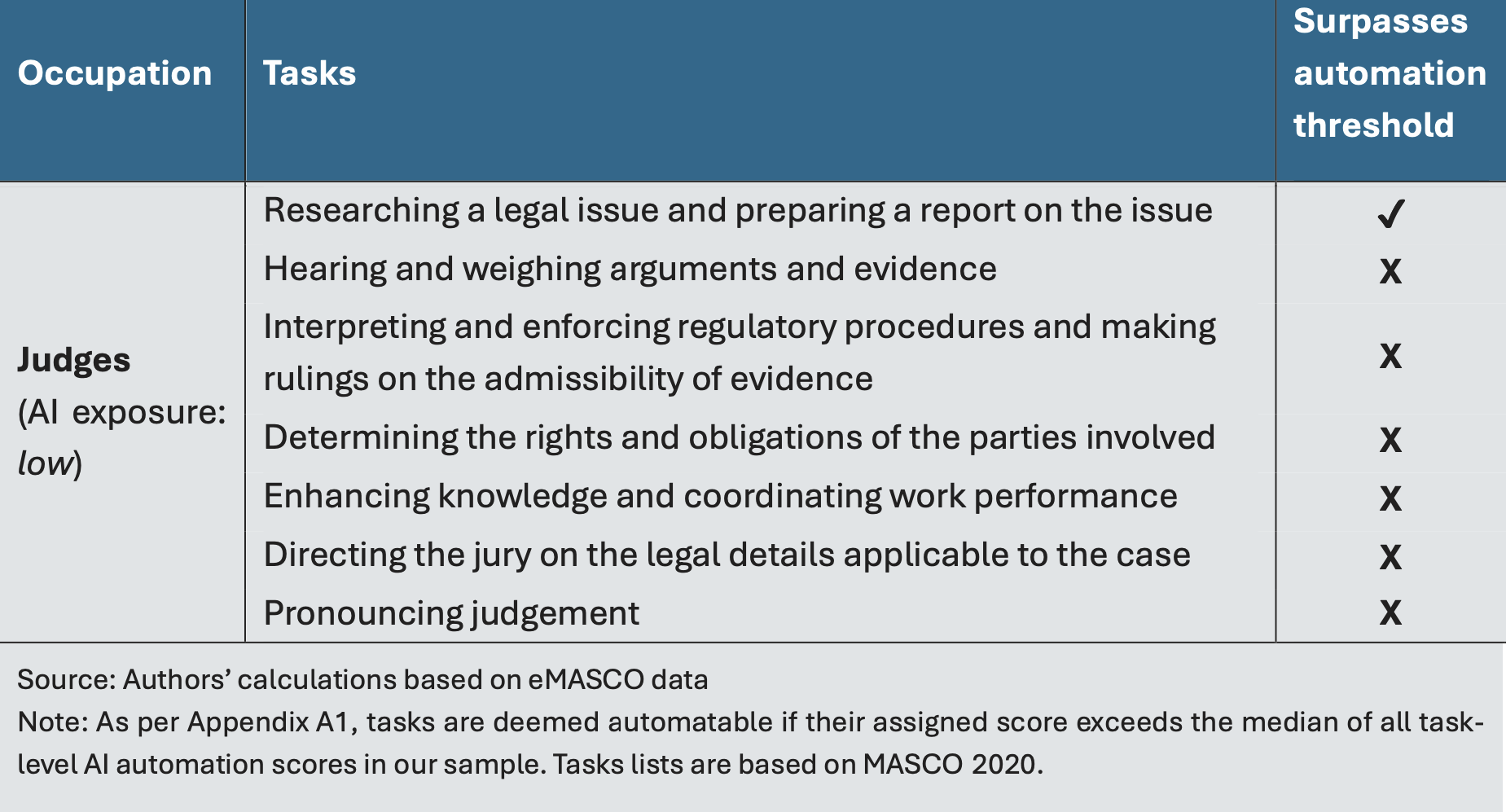
Overall, generative AI expands significantly the scope of automation into occupations involving higher-order cognitive tasks in the Malaysian context. Structured cognitive tasks (even those deemed non-routine) like data entry, basic document review and compiling information are increasingly able to be substituted by current technological capabilities. Nevertheless, occupations characterised by a high proportion of tasks involving complex problem-solving, nuanced judgement, interpersonal skills, as well as tasks requiring combined cognitive-physical capabilities, remain comparatively resilient to technological automation within the near-term horizon. In this way, generative AI may amplify past waves of routine-biased technological change while extending the automation frontier to higher-order – but still predictable and structured – cognitive tasks.44
An important caveat is that these estimates reflect whether tasks are automatable in principle by current generative AI technological capabilities rather than predicting actual job displacement. Real-world labour market outcomes hinge on many other factors beyond technology, including the speed and extent of generative AI adoption, policy and political constraints, and societal acceptance.45 Consequently, the task-level automation scores and occupational level AI exposure index estimated in this paper should be viewed as representing an upper-bound scenario of potential impacts from deployment of current generative AI technologies.
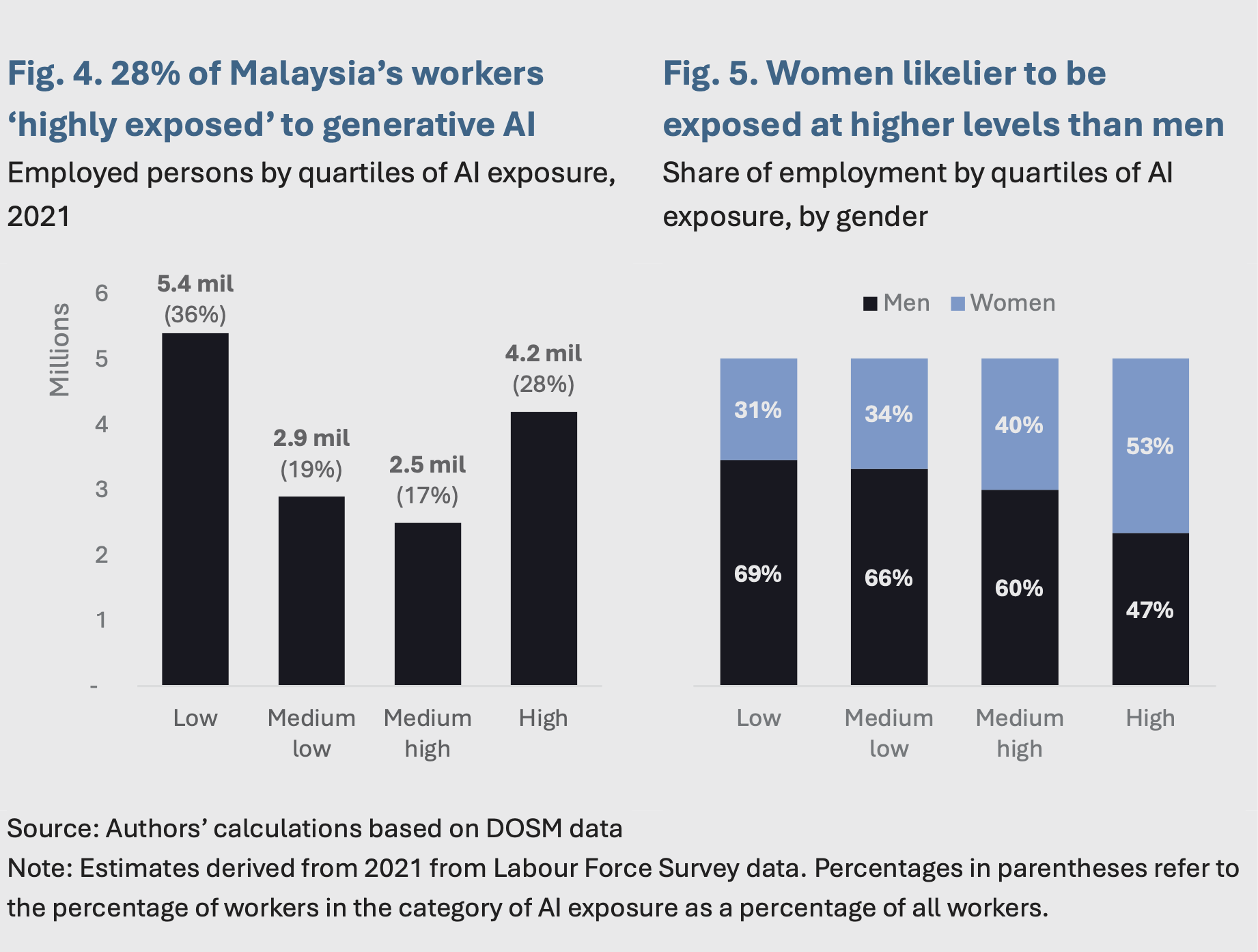
3.2 Mapping AI exposure index to the Malaysian labour force
This section examines the distribution of the AI exposure index among different socio-demographic groups. Given that our AI exposure index is estimated at the 4-digit occupation level, we mapped this index to the occupations of workers using the 2021 Labour Force Survey, a nationally representative survey conducted by the Department of Statistics. As in the previous section, we categorised occupation-level AI exposure index in quartiles: “low exposure”, “medium-low exposure”, “medium-high exposure” and “high exposure”.
While most workers are in the low exposure quartile, more than 1 in 4 workers are highly exposed to generative AI. About 5.4 million workers, amounting to 36% of total employment, are classified (Fig. 4). However, a significant share – about 4.2 million workers or 28% of the workforce – fall within the highest quartile of exposure. When combined with workers in the medium-high exposure category (2.5 million or 17%), around 6.7 million workers (45% of total employment) face notably elevated exposure to generative AI. These findings are roughly in line with previous estimates. The International Monetary Fund (2025), using methodologies developed by Felten et al. (2020) and Pizzinelli et al. (2023), similarly found that 48% of Malaysian workers were highly exposed to AI-driven automation.46 47 48
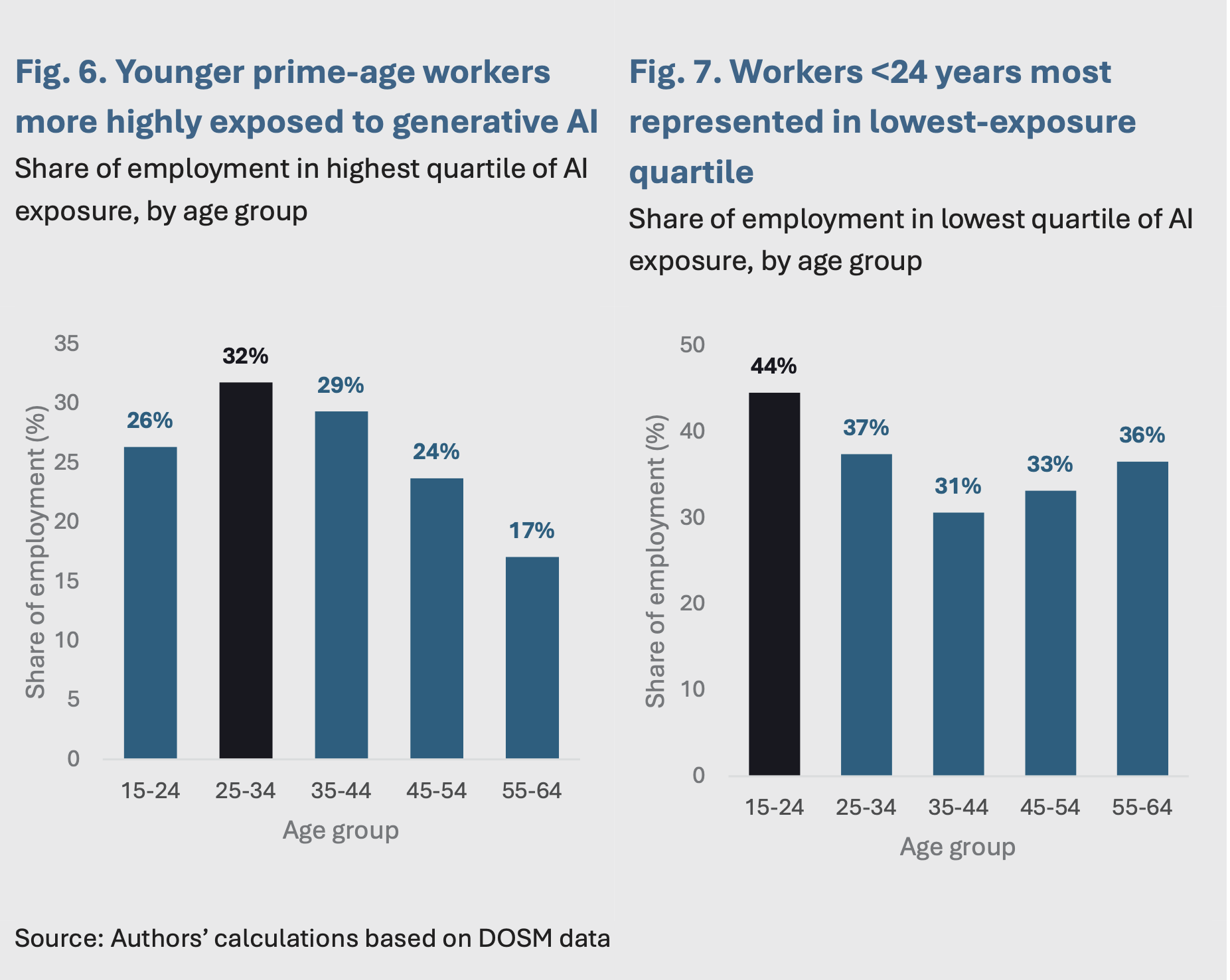
Women and younger prime-age workers are more highly exposed to generative AI, raising concerns about stalled mobility. As a share of all workers, women make up slightly more than half of those in the highly exposed category, despite lower labour force participation (Fig. 5). This is consistent with magnitudes found by past work on the region.49 50 Across age, the data show that the age share of workers in the highest quartile of AI exposure (Fig. 6) is an inverted U-shape – it peaks for younger prime-aged workers (25-34-year-olds), then falls for workers aged 45 and older (Fig. 6). On the end of the distribution, the youngest workers (15-24-year-olds) are most represented in the lowest-exposure quartile (Fig. 7). This is likely because the youngest cohort tend to take on manual roles that require little to no experience and therefore less susceptible to substitution by generative AI. Taken together, these figures could imply a worrying pattern: younger workers may become trapped in low-skilled roles, as entry-level cognitive jobs – typically rungs to more specialised, senior roles – are those most exposed to generative AI, deepening age-based polarisation.
Generative AI exposure rises with skill and education but peaks in the middle of the distribution, tapering off at the highest levels. Disaggregating generative AI exposure scores by skill level reveals that a larger share of mid-skilled workers is in the highest exposure category than high-skilled workers (56% and 44% respectively, Fig. 8). On the other hand, low-skilled workers are predominantly exposed at low levels. Exposure rises sharply with education levels before plateauing at higher qualifications: 46% of workers with post-secondary education falls into the highest exposure quartile, whereas this share declines slightly to 37% among workers with tertiary education (Fig. 9). These patterns suggest that generative AI exposure peaks within mid-to-high skill and education ranges, reflecting a plateau effect at the very top. Nonetheless, it is important to note that while higher-educated workers may face elevated exposure in relative terms, they are also more likely to able to leverage on this potential exposure for augmentation rather than substitution.51
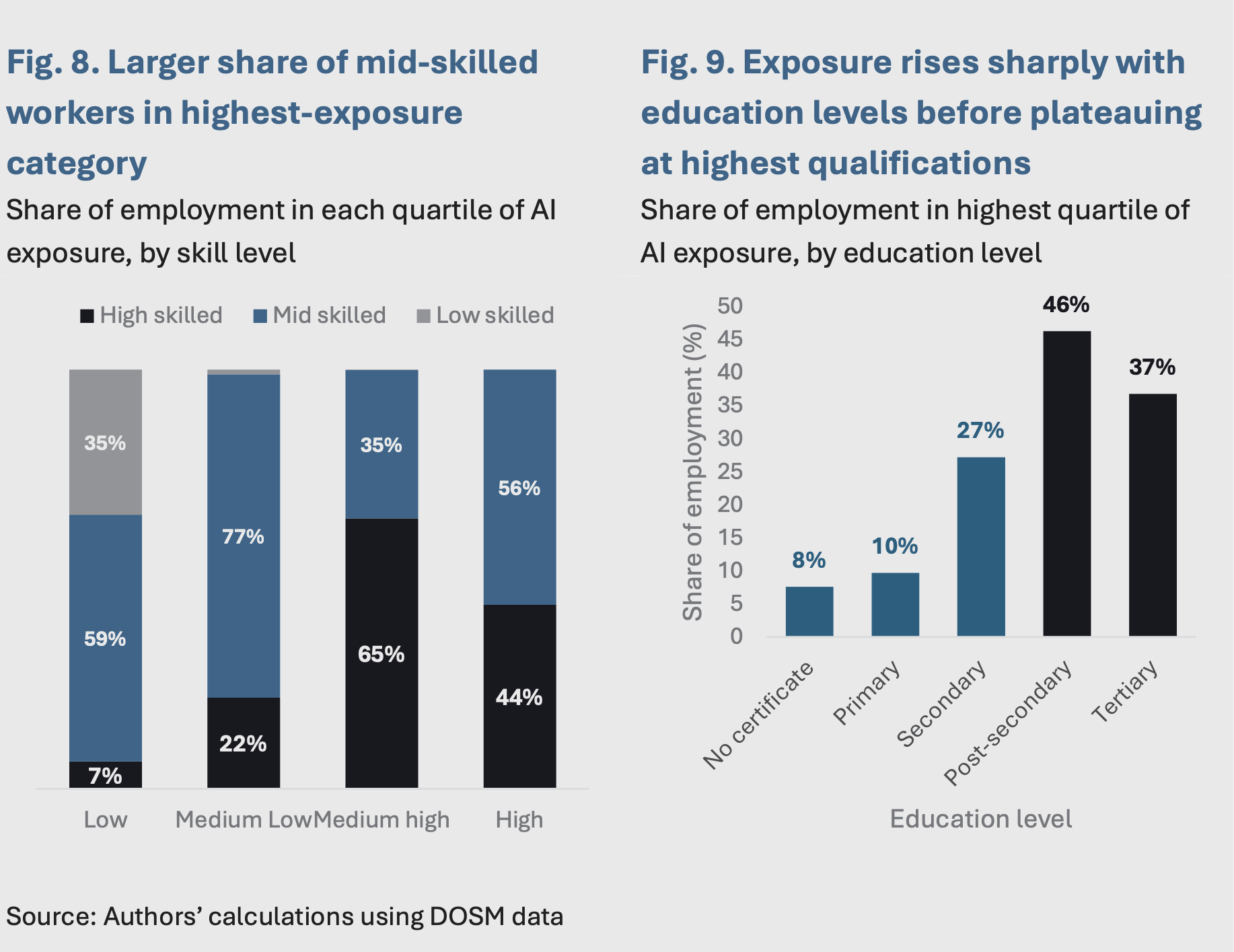
Breaking down the incidence by occupation, generative AI technology is expected to disproportionately affect knowledge workers. Clerical support workers are the most susceptible to generative AI (Fig. 10). Our estimates indicate that close to all clerical support workers are expected to be exposed to generative AI technology at medium-high to high levels. This is because clerical roles, such as secretaries and data entry clerks, are dominated by structured, predictable tasks, which generative AI technology can perform. As a share of employment, clerical support workers made up 10% in 2023, according to the Labour Force Survey. Additionally, workers in the technicians and associate professionals and professional categories also have relatively high exposure – occupations broadly associated with “knowledge work”.52 However, as posited earlier, high-skilled workers tend to have tasks that are more complementary to AI than clerical routine tasks.53 Disaggregating by sectors shows that the service sector has the lion’s share of workers highly exposed because of the high share of sales workers, office clerks and business and administration professionals. Zooming into more granular industry levels (2-digit Malaysia Standard Industrial classification), our data suggest that industries, such as insurance, real estate and other financial services, have the highest share of employed exposed at the highest level of AI exposure (Table 3).
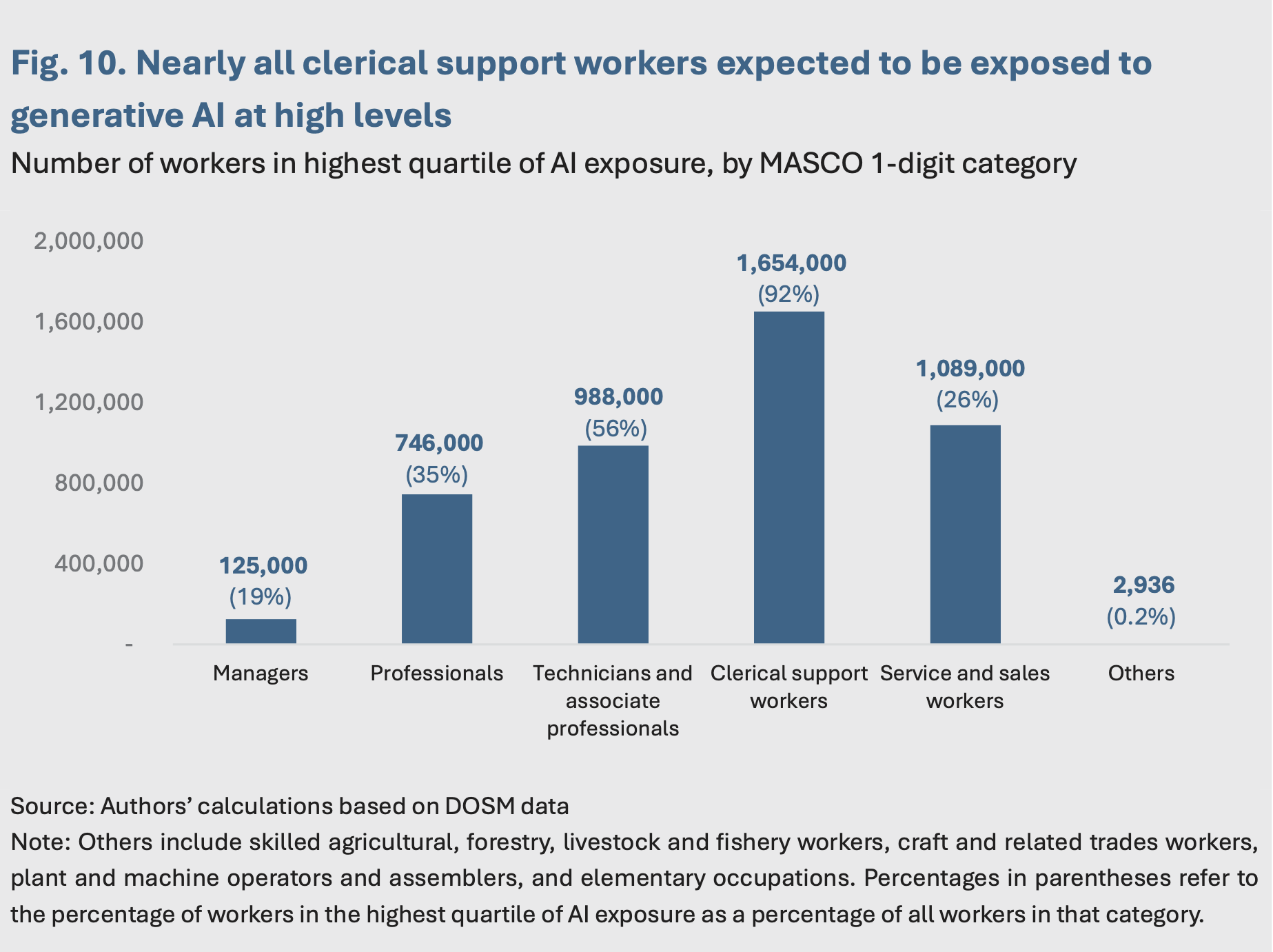
Table 3. Top 10 industries with highest medium to high AI exposure indexes
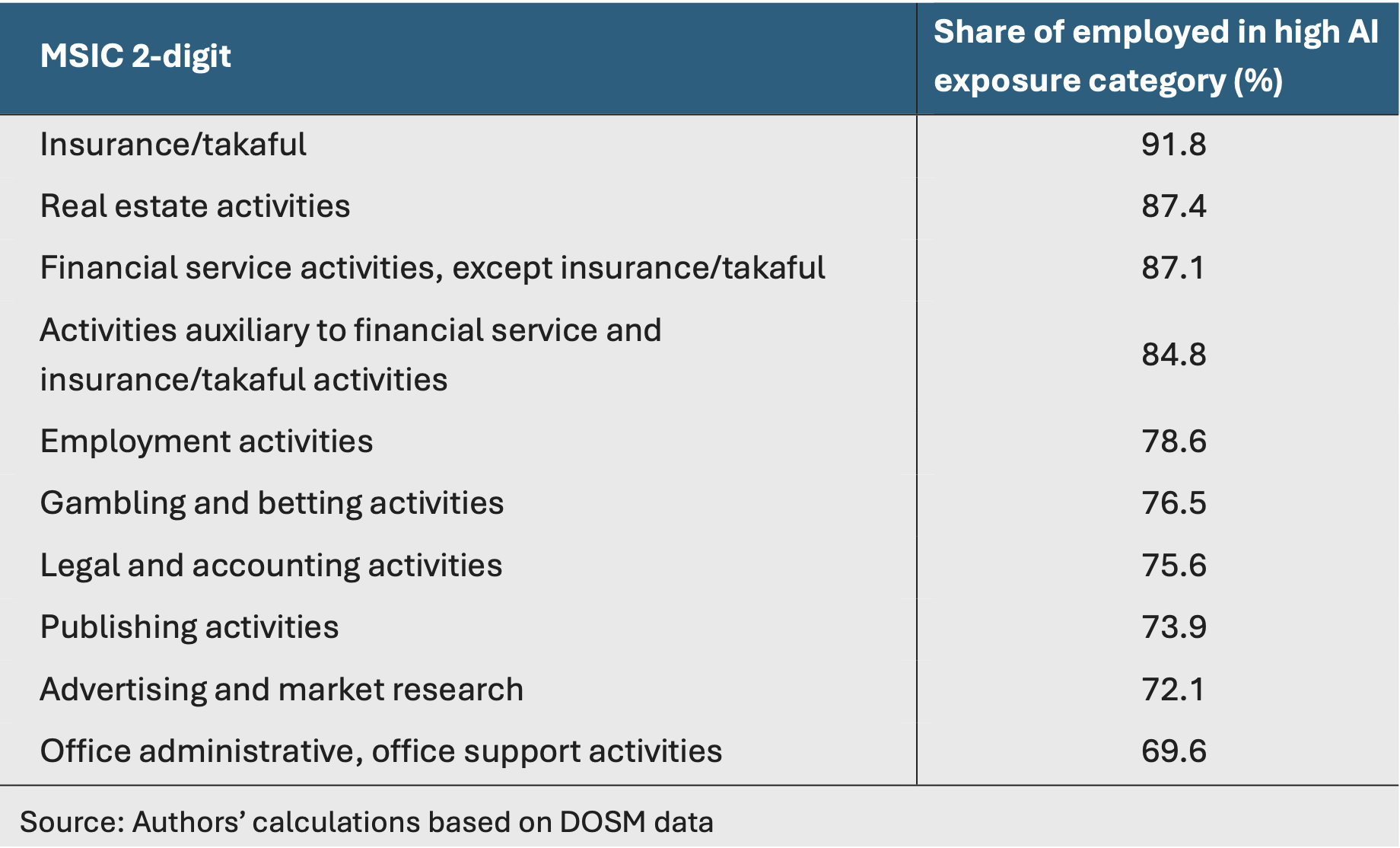
Higher-wage workers tend to have higher exposure to generative AI but this tapers off at the very top of the wage distribution. Fig. 11 and Fig. 12 show that, on average, AI exposure rises with wages. However, this relationship is non-monotonic. At the highest wage levels, namely at the top 20%, we observed the same plateau effect observed in skill and educational exposure: namely, exposure falls, underscoring that generative AI’s most significant potential impact lies in mid- to upper-middle-tier roles, while the very highest-paid positions – likely those with the highest proportion of their tasks comprising of creativity and complex socio-emotional judgement – remain relatively less exposed. Nuances of this wage-exposure pattern are explored further in the subsequent skills analysis in Section 3.3.
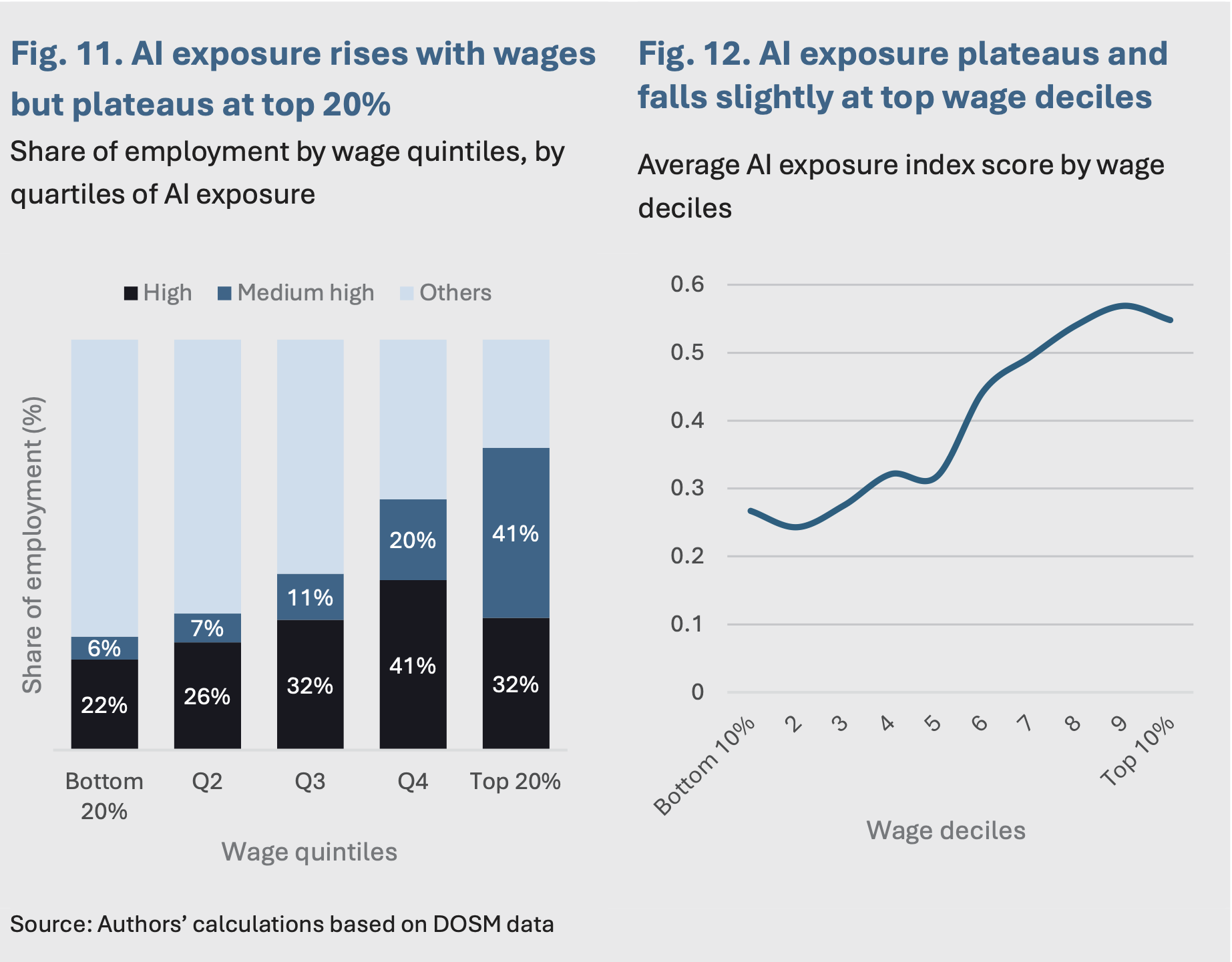
More developed states have a greater incidence of high AI exposure, reflecting a higher concentration of knowledge-intensive occupations. States with higher GDP per capita tend to have more “knowledge workers”, who are more likely to be exposed to generative AI technology (Fig. 13). For example, in Putrajaya where nearly half of the workers are highly exposed to AI, the majority are professionals and clerical support workers, primarily in the public sector. Conversely, in Terengganu with the lowest share of workers being highly exposed to generative AI, the majority are service and sales workers as well as craft and related trade workers.
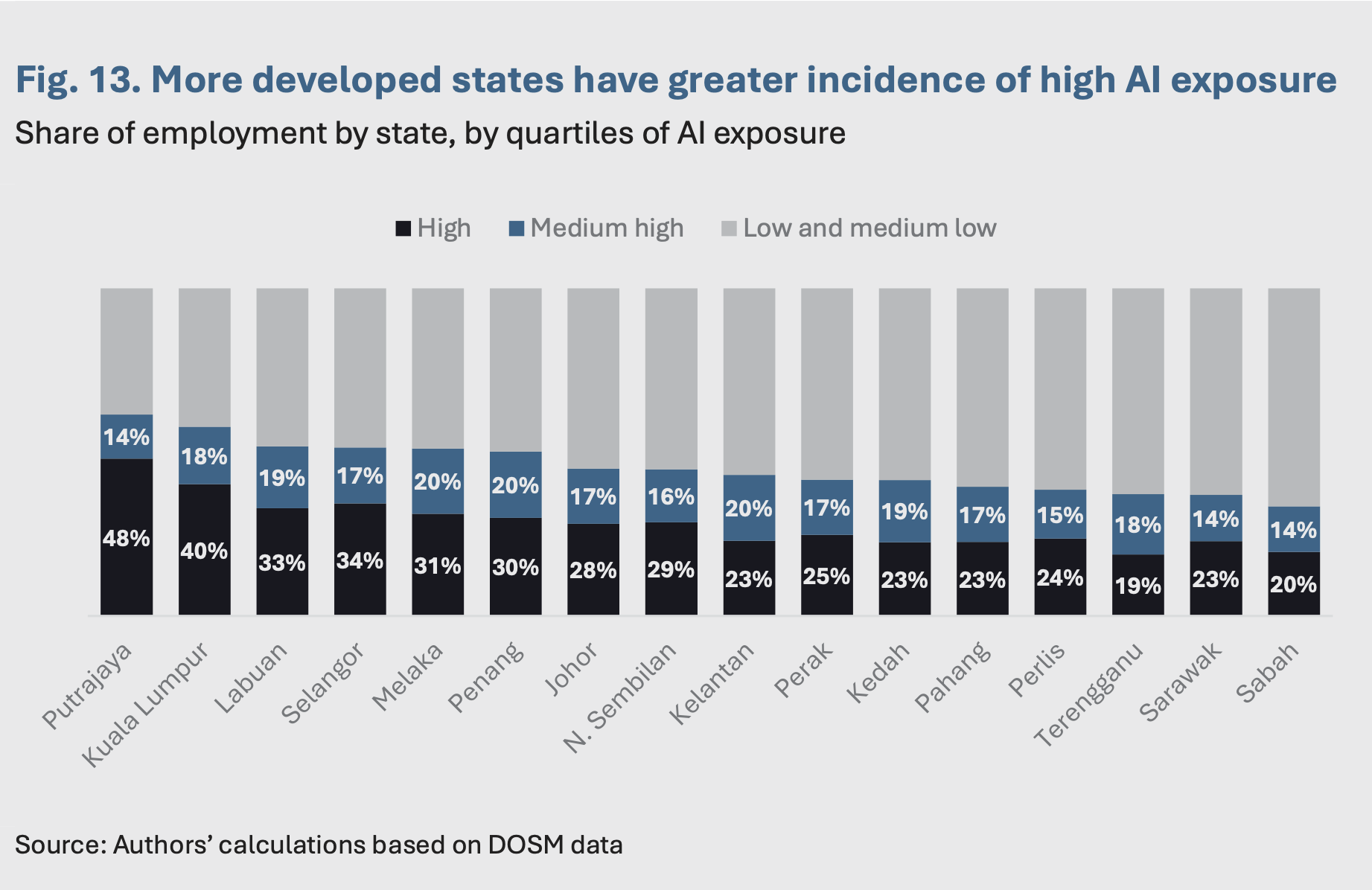
Regression analysis corroborates our findings that generative AI exposure is concentrated among women, younger adults, white-collar occupations and urban workers. Appendix A4 provides results of a probit regression of the probability that a worker falls in the top exposure quartile. Controlling for various socio-demographic variables, we find statistically significant evidence that men are 2.7% less likely and those who are older were also 0.3% less likely to be highly exposed. Relative to workers with no certificate, the probability of high exposure rises sharply for secondary and post-secondary graduates and then flattens for university degree-holders – echoing the plateau effect observed earlier. Clerical staff, technicians and professionals show the largest positive marginal effects, whereas craft and service workers are significantly less exposed. Sectoral patterns also align with task content: employment in services or manufacturing increases the likelihood of high exposure compared with agriculture, while construction remains comparatively sheltered. Urban employees were also more likely to be highly exposed than rural employees – given the higher share of high-skilled workers in these areas.
3.3 Skills analysis
In this subsection, we extend our analysis from the AI exposure scores of the MASCO 4-digit occupations to those at the more granular MASCO 6-digit occupations, which contain additional occupational details beyond task descriptions. The eMASCO website provides information on the basic skills and specific skills needed for each 6-digit occupation. We scraped 45 basic occupation skills, including basic ICT, communication, problem solving, persuasion and a total of 318 specific skills, including 3D animation, budget management, crisis management, farm machinery and laboratory testing. For each skill, we calculated an average AI exposure score by identifying the occupations that require the skill and taking the arithmetic mean of their respective AI exposure scores.
Higher-order reasoning skills and interpersonal skills are highlighted as the most prevalent skills in the occupations with the lowest exposure (Fig. 14). Leadership, management and problem-solving skills remain difficult to automate, potentially because of the fundamental limitations of AI systems in replicating the complex human cognitive process. While generative AI may automate structured cognitive tasks in knowledge-intensive roles, AI-generated output requires human oversight to ensure accuracy and relevance, as well as intervention in making ethical judgements. As such, human competencies in situational judgement, ability to respond to fast-paced dynamic situations, ethical reasoning and certain highly specific domain expertise will become increasingly valued. Similarly, interpersonal skills such as social perceptiveness, management and coordination, are featured in occupations that are, on average, less likely to be automated by generative AI. While AI-powered chatbots and virtual assistants are already automating basic customer service interactions, advanced interpersonal skills are required to establish trust, interpret non-verbal cues and navigate complex social dynamics – capabilities that continue to be uniquely human. Finally, skills pertaining to human-to-human interactions, including caregiving, performing surgery, and patient examination are less likely to be automated.
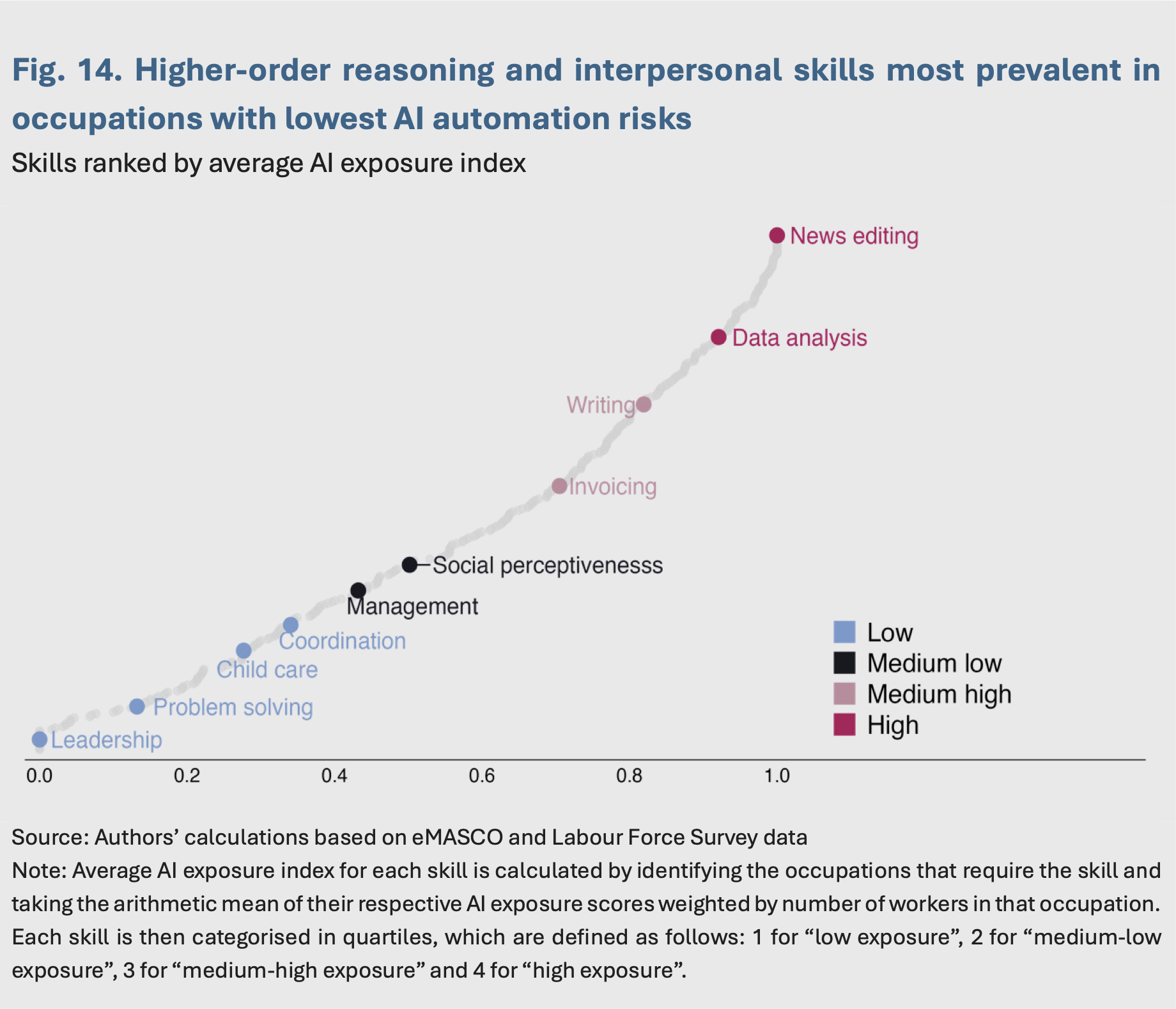
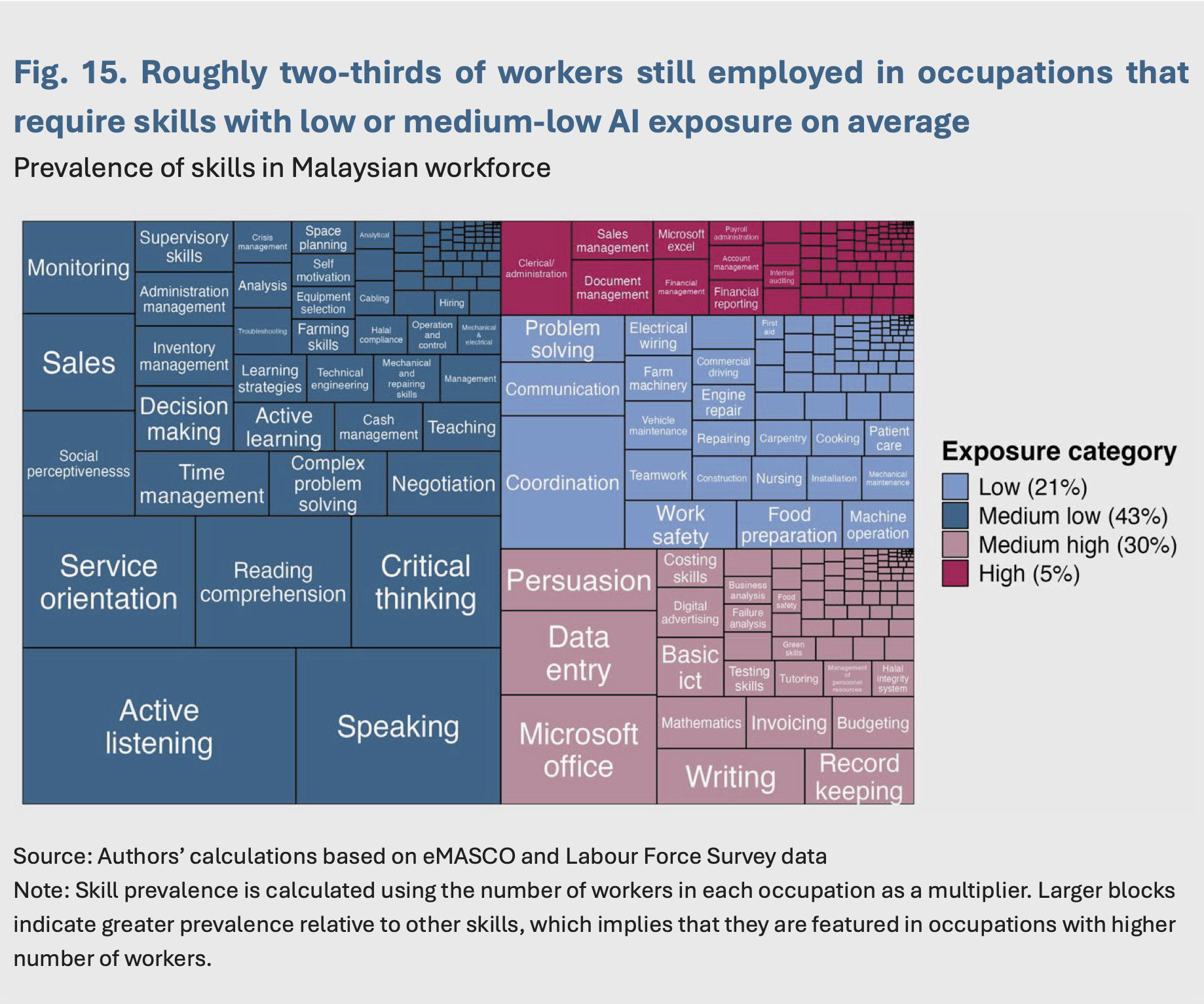
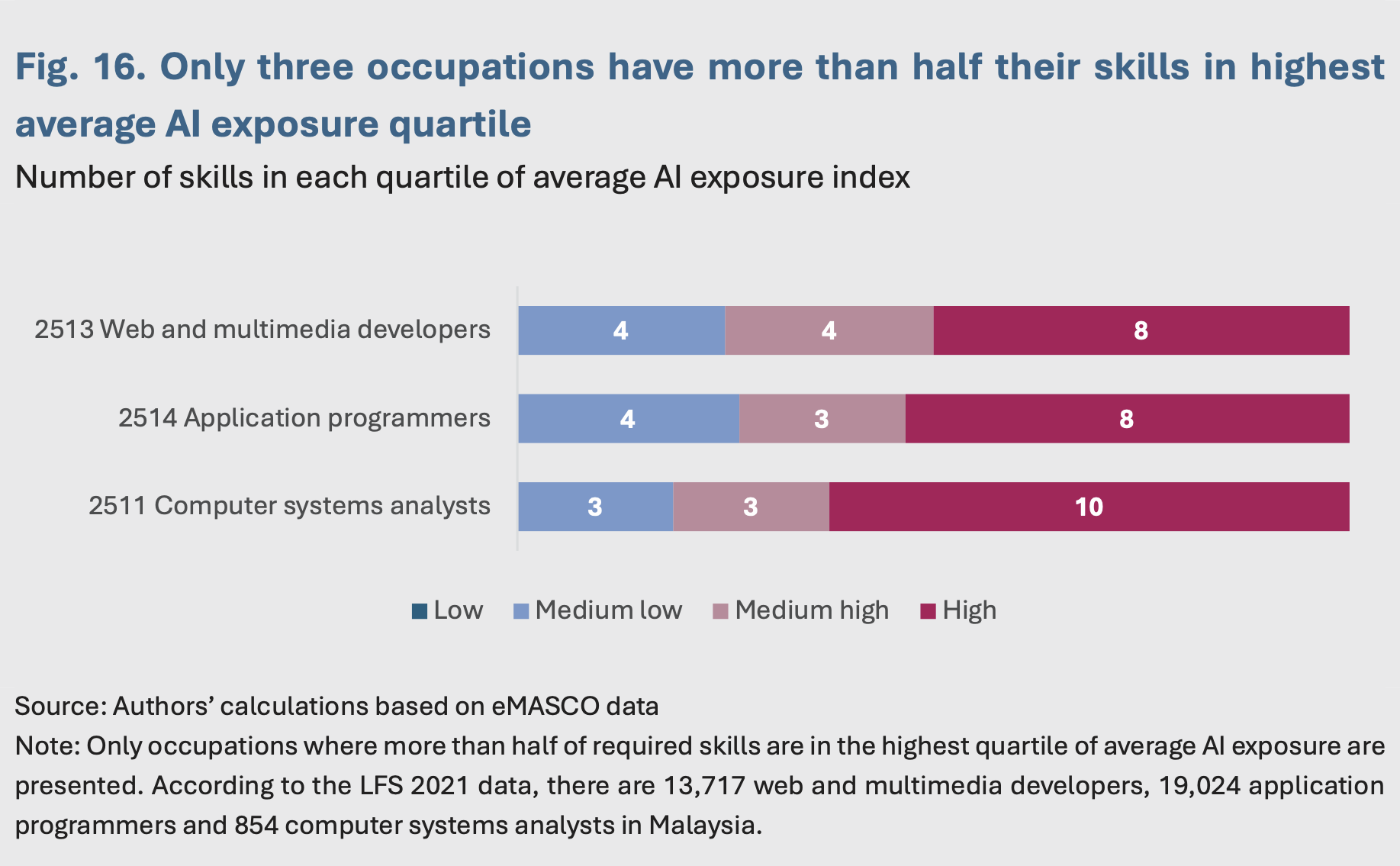
Skills in occupations in the highest quartile of generative AI exposure are still relatively scarce in the current Malaysian workforce. Currently, only 5% of workers are in occupations that have an average high-skill exposure, while a further 30% are in occupations with medium-high exposure on average (Fig. 15). This could suggest that disruptive impacts of generative AI are likely to be most apparent in specific industries or sectors. In fact, only three out of 484 occupations in our dataset have more than half of its skill-mix in the highest quartile of average AI exposure (Fig. 16), with all three of these occupations in the information technology sector. More importantly, many occupations still require a combination of both high-exposed and low-exposed skills, pointing at potential for AI to complement existing workflows.
Occupations that emphasise “human edge” skills may become more valuable as generative AI automation progresses. Using a list of 363 unique skills, we constructed a “human edge” variable that captures whether humans are likely to retain a comparative advantage over generative AI in performing each skill (Appendix A5). Mapping this variable to Labour Force Survey data reveal that roles dominated by “human edge” skills initially earn below-median wages – as compositionally they are dominated by physical-manual jobs like caregiving, personal services or manual trades that traditionally receive lower compensation. However, regression analysis uncovers a more nuanced pattern: at the highest levels of AI exposure, this wage disadvantage turns into a premium. Specifically, interaction terms in our wage-skill regressions show that when an occupation’s AI exposure index exceeds 0.8, human-edge skills are statistically significantly positively associated with higher median wages (Appendix A5). This suggests that the cognitive domains where humans maintain comparative advantages over generative AI could be increasingly valued in the future labour market as generative AI diffusion progresses. Conversely, occupations currently advantaged by their routine-cognitive content may start to face downward wage pressure as their skills become more replaceable by AI technologies.
Generative AI adoption may accelerate job polarisation by further reducing opportunities in routine-intensive occupations, continuing a trend observed in earlier waves of technological change. Job polarisation since the 1990s has been characterised by employment and wage growth concentrated at both extremes of the skill distribution, with stagnation or decline in the middle, as automation and digitisation disproportionately affected routine tasks.54 55 Our skill-wage analyses (Appendix A5) reveal that this pattern may intensify with generative AI. By mapping MASCO occupation skill requirements and median wages, we provide early evidence that an inverse-U-shaped relationship may exist between skill-wage levels and automation intensity (Fig. 17). Specifically, occupations at both ends of the skill spectrum remain relatively protected: the highest-end complex cognitive roles (e.g., contract negotiation, specialised medical expertise) and physical-manual or interpersonal roles (e.g., healthcare support, construction trades). Meanwhile, mid-to-high skilled occupations dominated by “routine-cognitive” and “non-routine structured” skills face the greatest automation risk. These results both align with and explain the mechanisms behind the “plateau effect” observed in Sections 3.1 and 3.2. Namely, workers at the top of the wage, education and skill distribution have the most nuanced, context-rich cognitive skills that generative AI struggles to perform currently.
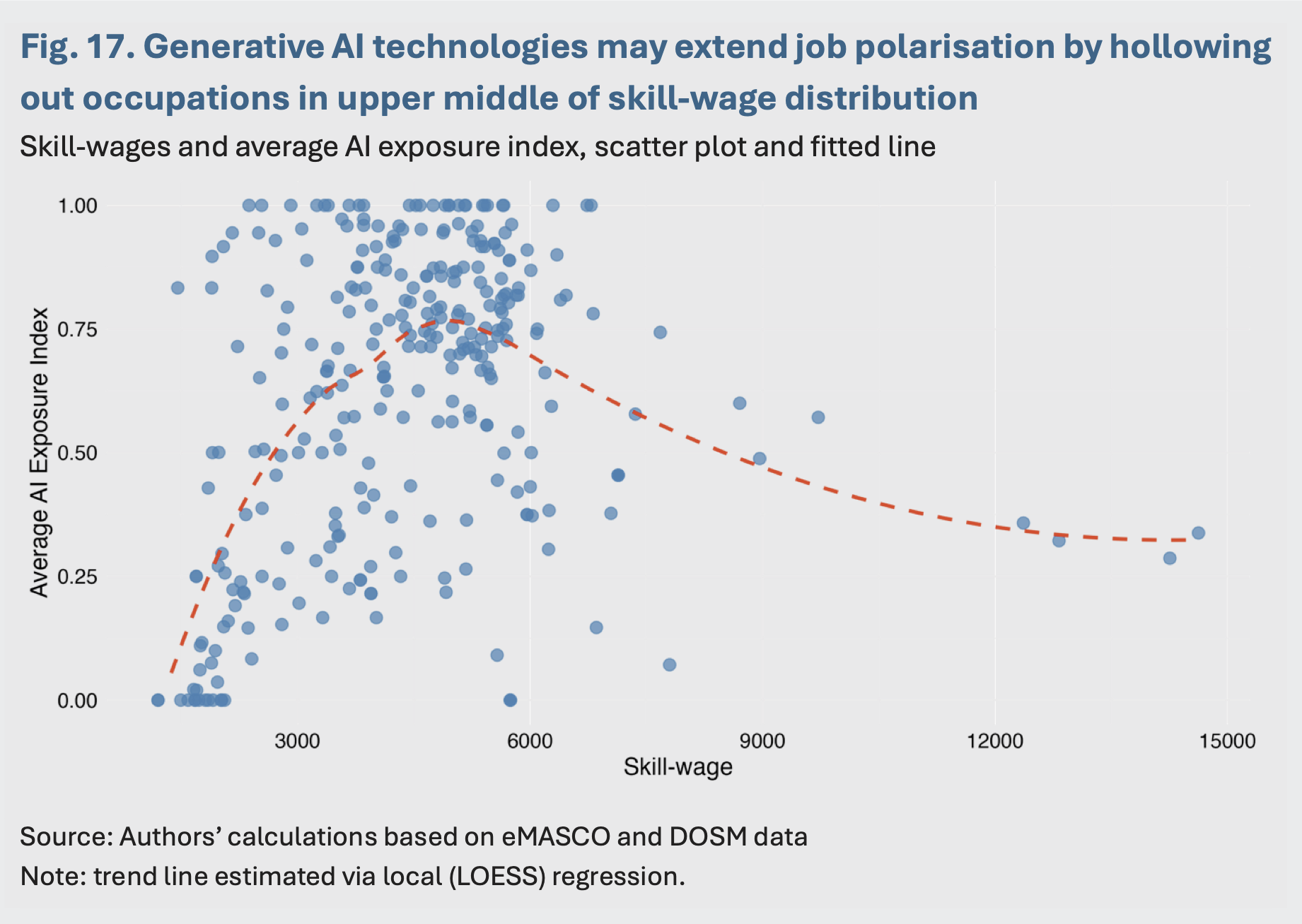
4 Summary and discussion of findings
Malaysia’s overall exposure to generative AI is relatively high. Mapping our task- level automation scores onto the 2021 Labour Force Survey data indicates that about 4.2 million Malaysian workers – or 28% of the labour force – sit in the highest quartile of generative AI exposure, while another 2.5 million workers fall in the medium-high exposure category. In summary, some 45% of the Malaysia’s workforce have at least 40% of its task mix automatable in principle by today’s generative AI capabilities. These exposure estimates place Malaysia close to global benchmarks and above earlier estimates in the Malaysian context.56 57
Generative AI exposure is uneven across gender, age and education. Job tasks substitutable by generative AI reflect structured, screen-based, repeatable, non- physical work and certain demographic groups are more likely to select into such occupations. This manifests in differential exposure across socio-demographic groups (Section 3.2). Namely, women are almost twice as likely as men to occupy highly exposed occupations, while younger prime-age workers cluster in the top quartiles of generative AI exposure. Overall, regression analysis indicates that women, younger workers, clerical workers and urban workers are more likely to be in AI-exposed jobs (Appendix A4) – in line with trends observed with international evidence.58
Generative AI could extend routine-biased technological change and deepen job polarisation. Our analysis in Section 1 suggests that generative AI can now substitute for structured yet non-routine activities, pushing the automation frontier towards non- routine tasks. This amounts to a pattern of “structured-biased” technological change that builds directly on earlier routine-biased waves. Likewise, our skills analysis (Section 3.3) reveals an “inverted-U” shape: exposure climbs through the middle of the skill-wage distribution, hollowing out mid-level knowledge roles, but falls again for at very highest skill tiers, in line with recent evidence surrounding task complexity.59 60 61 A similar “plateau effect” appears at the top education, skill and wage ladders (Section 3.2), indicating that generative AI could deepen patterns of job polarisation observed in some developed countries since the 1990s.62
Looking ahead, the future of work with generative AI could be more fluid yet potentially less equal. Our framework uses static occupation-task structures and as such does not capture shifts in task mixes or the creation of new tasks in response to AI diffusion. Nonetheless, our results suggest several implications for what such shifts could be. By accelerating task re-bundling, generative AI could accelerate skill churn as well as raise wage premiums on “human-edge” abilities, including complex judgement, social-emotional and interpersonal reasoning, as well as creativity (Section 3.3). Combined with the uneven exposure patterns and patterns of job polarisation, along with a long-run shift towards greater capital intensity that has eroded the labour share of income,63 large-scale diffusion of generative AI could further entrench existing inequalities.
Longer-term impacts of generative AI diffusion remain uncertain but well-designed policies could maximise benefits and limit risks. Economy-wide productivity gains and the emergence of wholly new tasks and occupations brought about by AI technologies could, in theory, offset potential negative impacts on inequality to deliver broader prosperity – though the balance between AI as an “enabling” versus a “replacing” force remains uncertain.64 Policy tools can help tilt the balance towards the positive by strengthening social protection for displaced workers, expanding lifelong-learning and educations systems that help build “human-edge” skills, and incentivising labour-complementary deployment of generative AI. The following section explores some initial policy ideas along these lines, focusing on (i) social protection and (ii) education and training.
5 Policy recommendations
This section sets out three complementary policy directions. First, we outline avenues towards strengthening social protection systems so that all workers, including those engaged in non-standard work, are insured against the potential shocks explored in Section 3. Second, we suggest changes to education, training and lifelong-learning pathways to equip Malaysians with the “human-edge” skills for the future of work, along with measures to broaden access to these learning pathways. Third, we suggest some ways to realign labour-market institutions and employer incentives to favour labour-complementary adoption and raise job quality in occupations that are resilient to automation.
5.1 Social protection
5.1.1 Extend unemployment insurance to all workers
Given that generative AI technologies have the potential to displace certain job roles or tasks – particularly those involving routine and repetitive tasks – extending unemployment insurance to all workers, especially informally employed workers, is crucial. Unlike formal workers who benefit from social insurance schemes provided by the Employees Provident Fund (EPF) and Social Security Organisation (Perkeso), informally employed workers, including the self-employed, are often excluded from such protections. This is the case for the Employment Insurance System (EIS), which is a contributory social insurance programme administered by Perkeso designed to provide income support and employment services to private sector workers in the event of loss of employment. Self-employed workers do not have access to unemployment benefits under the EIS.
To protect all workers potentially displaced by generative AI technologies, Malaysia should extend EIS coverage to segments of the labour market not already covered. It could move in this direction with a voluntary scheme, akin to EPF’s i-Saraan, and co-contribute to encourage uptake.
5.1.2 Strengthen social safety nets
Global experience suggests that even with the provision of generous subsidies, it can be challenging to extend social insurance (including employment insurance) to all workers. It is inevitable that some workers will remain uncovered by such schemes. Minimum social safety nets that are non-contributory or do not require a contribution from the worker will be important to support workers and their dependents. As always, the design of such safety nets will need to be considered carefully to avoid any unintended labour market impacts (given potential impacts on incentives for the labour market as a whole). Non contributory social safety nets have the added advantage of being funded through consolidated revenue rather than employment/payroll-related deductions or taxation, meaning their cost is shouldered more broadly.65
Already in Malaysia, programmes like the Sumbangan Tunai Rahmah (STR) cash transfers provide a minimum safety net to poor households. While coverage across such social assistance programmes is high, with about 66% of Malaysian households as recipients, the generosity of these programmes is limited. Benefit levels from non-contributory social assistance programmes (both cash and in-kind) are 9.5% of pre-transfer income on average for B20 households, well below the average for both high-income economies (19%) and other upper-middle-income economies (25%).66
There is also considerable fragmentation of social assistance programmes. More than 155 federal government programmes are delivered by 18 different agencies, many with different assessment and application criteria. This can be a challenging landscape to navigate for individuals in need of assistance – consolidation, especially at the client-facing “shopfront” – is warranted.
5.1.3 Streamline and strengthen lifelong learning opportunities
The provision of lifelong-learning opportunities is important to equip workers impacted by AI technologies with the right skills to work effectively alongside AI or to transition smoothly to other roles through high-quality skills training. This is especially crucial for lower-skilled workers, as highly educated workers tend to adapt more readily and be more familiar with digital technologies.67
Malaysia already offers a broad suite of skills training programmes to individuals. These include in-house skills training provided by Human Resources Development (HRD) Corp for private employees and the e LATiH platform accessible to all Malaysians seeking training; EIS skills training for EIS members and MyFutureJobs for all jobseekers seeking training provided by Perkeso; the Learn for Free programme focusing on the digital economy and digital skills provided by the Malaysia Digital Economy Corporation (MDEC) and various other ministries providing skills training according to their mandate. However, with so many upskilling opportunities, there are risks of fragmentation and duplication, leading to inefficiencies, as well as the risk that potential beneficiaries face difficulties navigating a complicated training landscape to identify the most suitable opportunities.
Streamlining skills training through a one-stop centre would simplify the user journey by offering clear guidance on which courses are most relevant based on a worker’s current role, skill level and career aspirations, removing the need to navigate multiple agency portals or programmes with overlapping objectives. The MyMahir.my platform, developed by TalentCorp under the Human Resources Ministry, represents a promising foundation in the broader strategy to prepare the workforce for AI-driven transformation. To maximise its impact, continuous user feedback should be established to improve its accessibility, usability and relevance. Regular assessments of user engagement, programme uptake and training outcomes are critical in refining its effectiveness and ensuring it meets the evolving needs of the workforce.
In the longer term, rethinking the current HRD levy funding model for skills training – which is tied to limited eligibility criteria and an employer-bound structure – may help increase access to lifelong learning opportunities. Reform could involve introducing individualised learning credits, through a portable “skills funding” digital wallet. Such an initiative, already in place in Singapore, could be funded through unclaimed HRD levies, supplemented by employer co-payments and government grants to create a flexible funding mechanism that follows workers throughout their careers.
5.2 Education, training and job quality
5.2.1 Mainstream AI education while strengthening foundational critical skills across primary and secondary curriculum
Generative AI tools are set to become as commonplace as word-processing tools or the internet (Section 1). Indeed, our analysis in Section 3.1 suggests that almost every occupation in our dataset – including those typically considered physical or low-tech – now contain tasks exposed to generative AI. As such, there is a need to mainstream AI education into the national curriculum, just as ICT education was mainstreamed in public schools in the 1990s during the Sixth Malaysia Plan. Instruction needs to cover both practical AI skills as well as responsible-use principles, such as ethics, veracity, privacy, bias and potential adverse environmental impacts of increased AI usage.
More importantly, these efforts must ensure that AI education reinforces, not replaces, the foundational numeracy, logic and language abilities that allow pupils to challenge and complement AI outputs. Put simply, schools must teach when to use AI and when to disconnect. Even before generative AI, surveys of adult skills across industrialised economies suggest that adaptive problem-solving and other critical skills have been stagnating or declining over the past couple of decades (OECD, 2024) and early evidence already links heavy reliance on generative AI tools to “metacognitive laziness”, which risks further eroding these basic competencies.68
To this end, policymakers can explore three areas in line with the objectives of Malaysia’s National AI Roadmap 2021–2025. First, develop a national AI literacy framework: a standardised, biennially reviewed AI literacy framework that mainstreams AI education into primary and secondary school curricula. Each AI module should be paired with a “manual competence” counterpart with clear learning outcomes. Similar initiatives are already underway in countries such as Estonia, where anecdotal evidence suggests that children can usefully acquire such skills early on.69 Second, expand the AI Education for Educators programme into a compulsory, continuous, credit-bearing professional-development track for teachers that include stackable micro-credentials (Section 5.2.4) and national mentor-expert networks built on existing teacher professional development (TPD/PLC) structures. Third, close regional digital gaps in schools through accelerating targeted investments that explicitly guarantee minimum connectivity and device ratios across all classrooms regionwide (by enforcing results-based USP fund disbursement rules), while establishing regional AI learning hubs to pool hardware and resources for both teacher training and pupil learning that individual schools might not be able to afford.
5.2.2 Cultivate ‘human edge’ competencies like social intelligence and creativity
Beyond technical proficiency and AI education, the curriculum should also prioritise the development of skills that, for now, remain uniquely human. Our findings in Section 3.3 suggest that human social intelligence, complex psycho-emotional reasoning, creativity and critical thinking continue to maintain significant competitive advantages over AI systems and could command increasing wage premiums as generative AI adoption accelerates. Indeed, the case for strengthening social-emotional learning extends well beyond vocational or productivity considerations. Research indicates that emphasising these social-emotional competencies in school curricula could itself lead to improved pupil life outcomes, enhanced pro-social behaviour, and greater civic engagement – all essential ingredients for nation-building amid disruption.70 This also aligns with broader efforts to build pupils’ “capacity to learn”, a foundational skill for navigating lifelong transitions in a rapidly evolving labour market.
In line with current efforts amid the upcoming National Education Reform, this would first require policymakers to redesign language arts curricula (including English, Bahasa Malaysia and vernacular languages) to strengthen both verbal and non-verbal communication skills. This could mean incorporating storytelling, drama, collaborative presentations as core modules – in turn, emphasising nuanced expression and reception of complex ideas. Second, public schools could strengthen the adoption project-based learning methodologies as default pedagogy for secondary schools, requiring pupils to collaborate on interdisciplinary team projects.
Third, education policy could prioritise structured cross-school collaboration networks, leveraging on DELIMa and existing cluster-school schemes. This would allow urban-rural and private-public school pupils to engage in collaborative problem-solving in “offline challenges” centred on real-world problems. While many of these initiatives have already been adopted (often in piecemeal form), efforts can be focused on strengthening the quality and consistency of delivery, particularly by enhancing pedagogical capacity through embedding these approaches into teacher qualification standards.
5.2.3 Integrate AI skills across higher education curricula beyond STEM disciplines
Generative AI is rapidly proving itself to be a general-purpose technology (like the water wheel and the internet), with use cases extending far beyond traditional STEM fields.71 Disciplines, including law, social sciences and humanities, are increasingly intersecting with AI applications, confronting both new opportunities and challenges in ethics and regulation. As such, a broad-based integration of AI tools and concepts into higher education curricula is essential to ensure Malaysia’s graduates across all fields are prepared to navigate both the potential and limitations of AI.
To start, beyond the provision of incentives (such as those in Budget 2025), policymakers need to develop clear guidelines for public universities to incorporate AI components across degree programmes, regardless of discipline. As in Section 5.2.1, this needs to cover model limitations and ethical use – as well as how and when to “disconnect”. Similarly, policymakers could incentivise the creation of specific interdisciplinary “AI + X” degree programmes that blend AI expertise with domain- specific knowledge, drawing from China’s recent higher education reforms in areas like law, business, and social sciences.72 73 Third, establishing pilot programmes at selected top public universities, implemented in collaboration with technology firms and research organisations, could serve as models for integrating AI curricula in non-STEM disciplines across the entire higher education system.
5.2.4 Promote modular, stackable credentials, without sacrificing wider benefits of higher education
Our analysis (Section 3.1) indicates that about one-fifth of job tasks in Malaysia are prone to automation, suggesting that the skills landscape will undergo significant change and transformation. Traditional four-year university degrees remain vital for nurturing critical inquiry, civic consciousness and social networks – yet, on their own, they struggle to keep pace with rapid skill churn. As such, the goal should be to create flexible pathways that allow students to top up specific competencies while still preserving the intellectual and social benefits of universities. Malaysia has taken early steps. The Malaysian Qualifications Agency (MQA) issued micro-credential guidelines in 2021, several public universities run accredited micro-courses and some e-LATiH platform courses have badged modules. Yet, provision remains fragmented, quality uneven and many courses cannot be stacked easily into larger qualifications.
Policymakers could build on existing MQA micro-credential guidelines to outline a national stackable-credential framework incorporated into single stackable-credential framework anchored to the MQA guidelines. Every micro-credential would then carry a specific credit value and recorded on a shared digital ledger (e.g. Australia’s My eQuals). This would let accumulated credits move frictionlessly across institutions and count for a portion of a degree. Additionally, to raise quality and signalling power, MQA and the Department of Skills Development could develop rigorous quality assurance standards for micro-credentials and publish outcome-based rubrics for each qualification level.
5.3 Labour market institutions
5.3.1 Make it cheaper to invest in workers’ skills
Policymakers should create a more balanced incentive structure that makes it financially advantageous for employers to invest in retraining workers rather than replacing them with automated systems. This approach would help preserve valuable firm-specific human capital, reduce excessive displacement, and enable workers to develop the higher-order reasoning and interpersonal skills our analysis identifies as having the lowest automation risk.
To achieve this rebalancing, policymakers could explore different approaches. One priority should be to adjust the relative taxation of labour and capital: Malaysia’s social protection system is largely social insurance based, meaning it is funded by compulsory levies on wages. This system provides employers with economic incentives to substitute capital – including AI technologies – with labour, given lower effective taxation of the former. Redressing this should be a priority over the long term – as discussed earlier, there is a need to strengthen non-contributory safety nets (funded through general taxation). In the more immediate term, other options can also be considered, such as the introduction of targeted tax credits for employers who invest in developing the specific human-edge skills identified in Section 3.3, particularly for groups facing higher exposure. Similarly, establishing a matching fund programme prioritising states with higher exposure levels, where the government contributes to company-sponsored training designed to transition workers from routine cognitive tasks towards roles emphasising the interpersonal and higher-order reasoning skills, our analysis shows command wage premiums in an AI-augmented economy.
5.3.2 Ensure job quality and labour market institutions to form countervailing force
Occupations requiring significant physical dexterity and interpersonal interactions – such as caregiving, personal services and manual trades – remain largely resistant to generative AI-driven automation (Section 3.1). As technological change potentially reinforces existing labour market polarisation, policy action should focus on improving job quality and strengthening worker voice in these essential but traditionally undervalued sectors.
On this front, policymakers should implement a comprehensive approach. First, enhance job quality in automation-resistant occupations through periodic minimum wage reviews, expanded social protections (Section 4) and strengthened occupational health and safety standards. Second, modernise labour market institutions by supporting new forms of worker organisation beyond traditional unions, particularly in sectors with high interpersonal skill requirements where collective representation has historically been limited. Anecdotal evidence from other domains, including civil society pressure driving environmental sustainability commitments and digital platform governance, demonstrates that organised civil society action can effectively balance technological advancement with social welfare.74
Note: a technical appendix is included in the online PDF version of this paper



